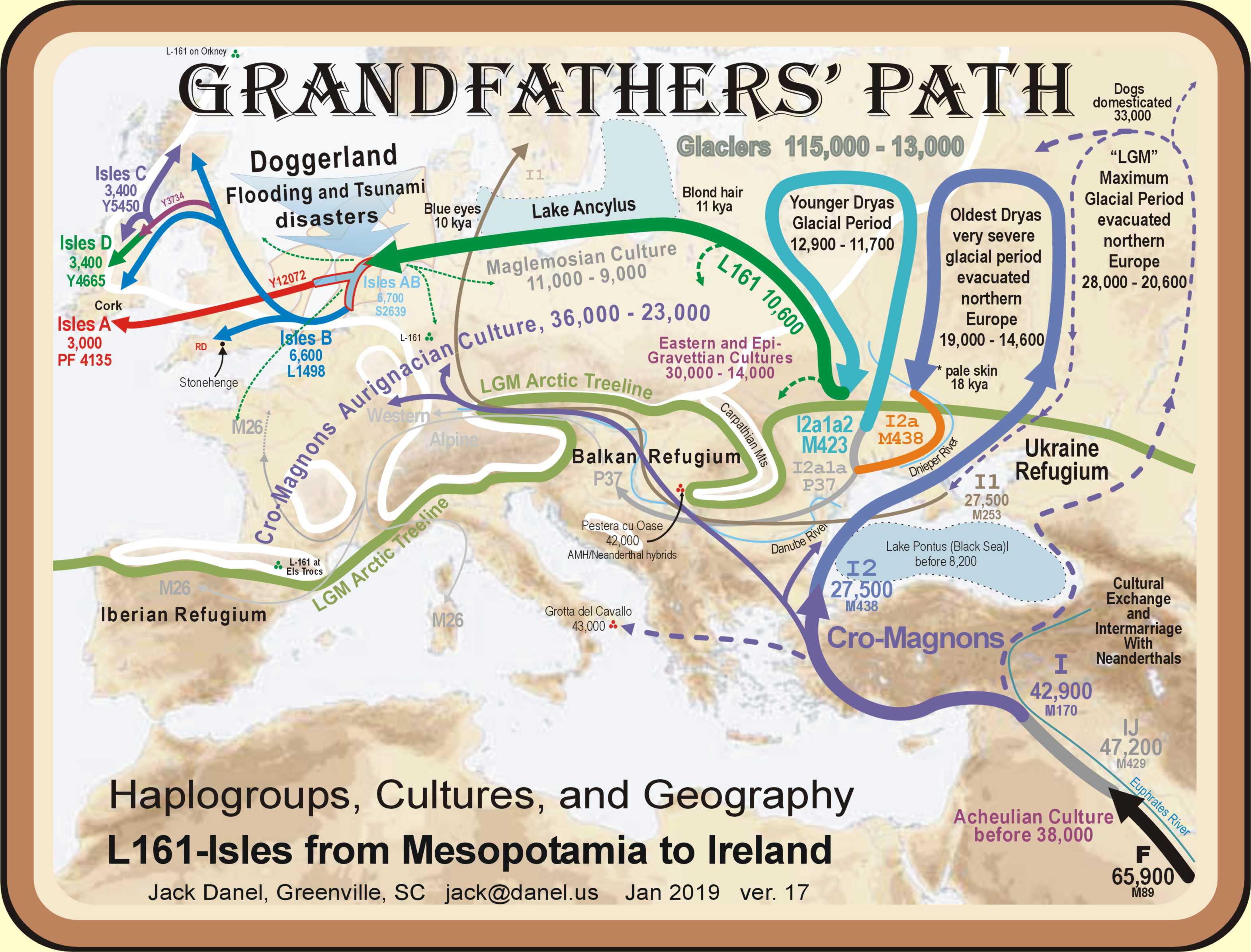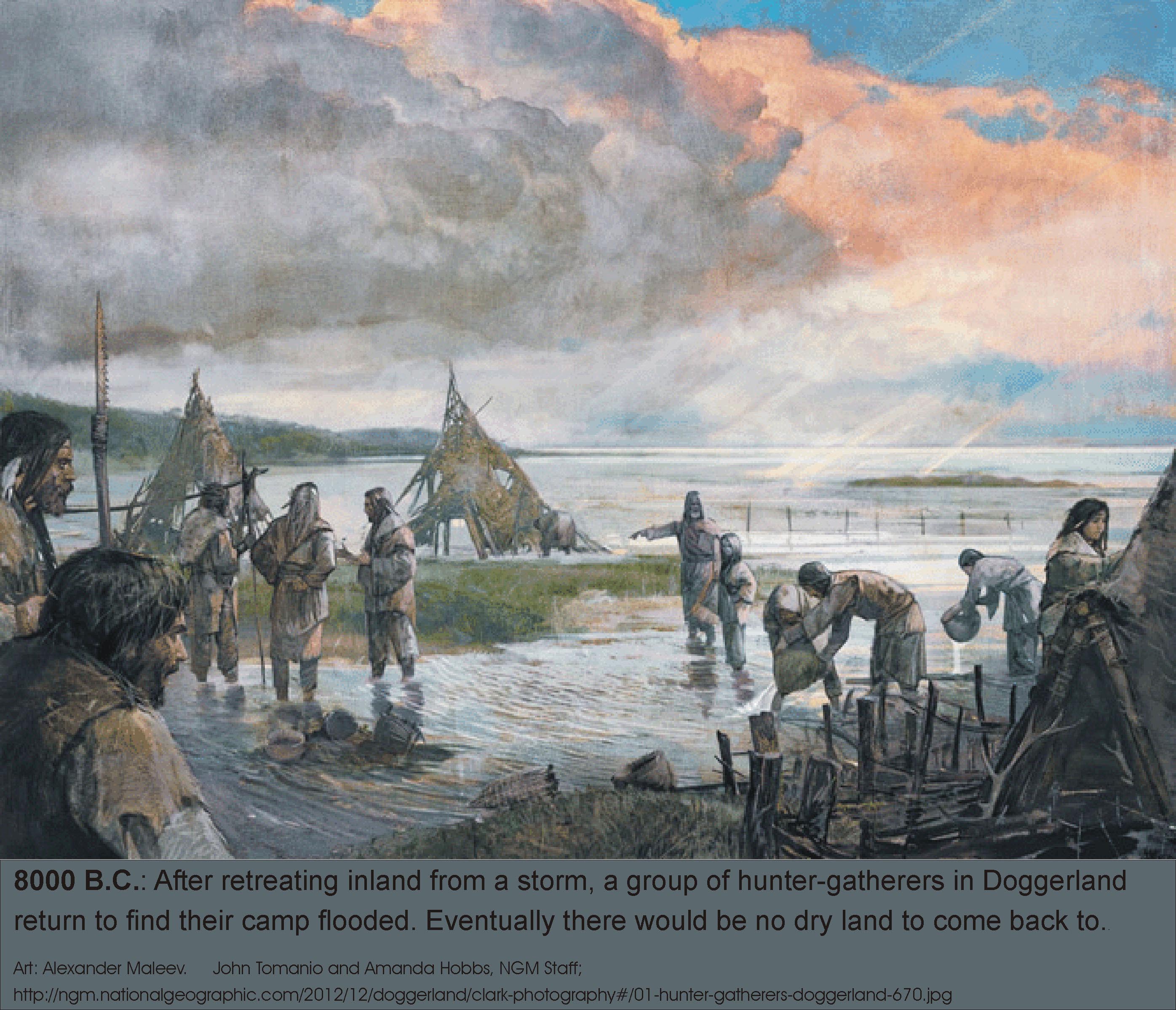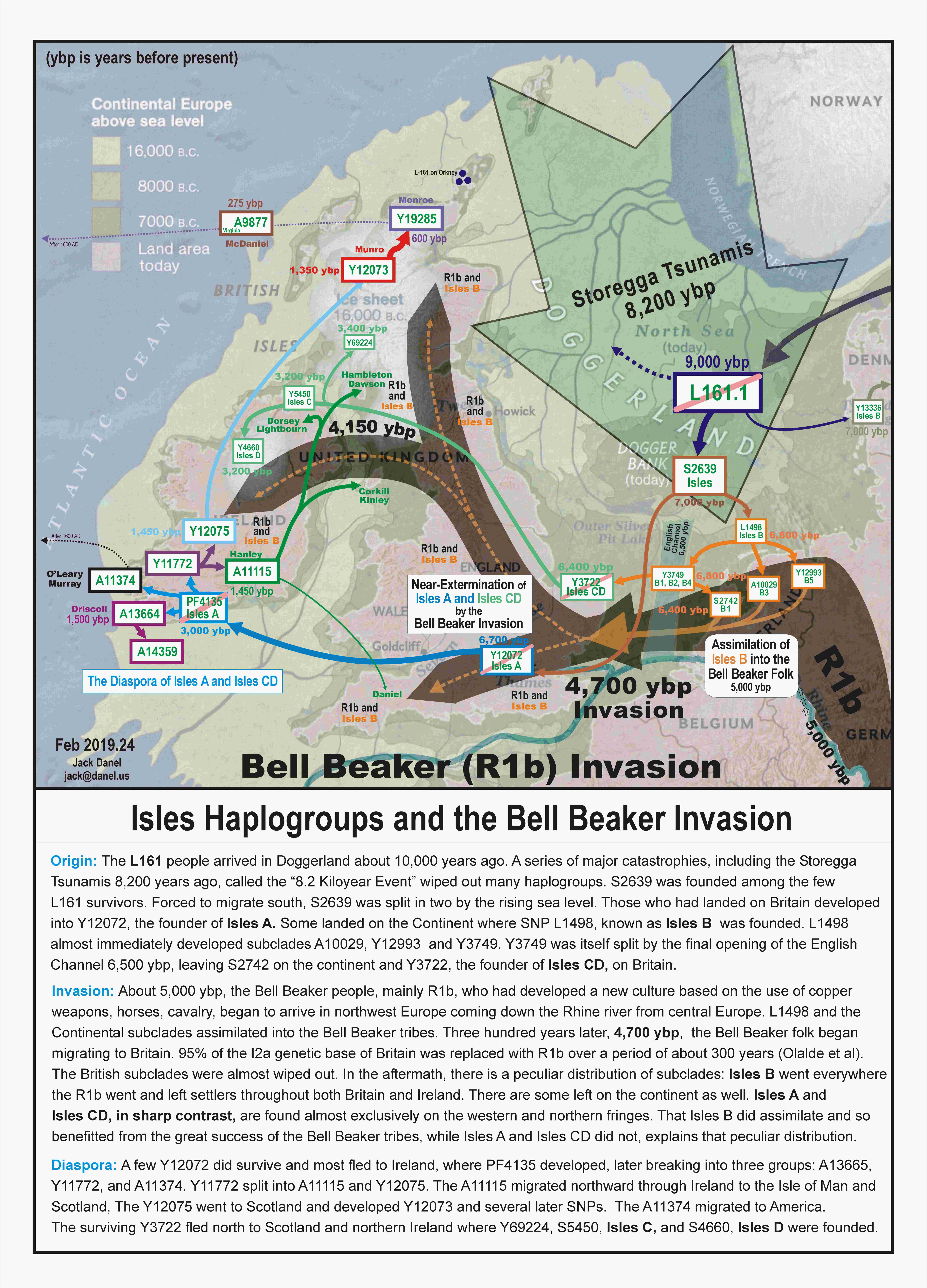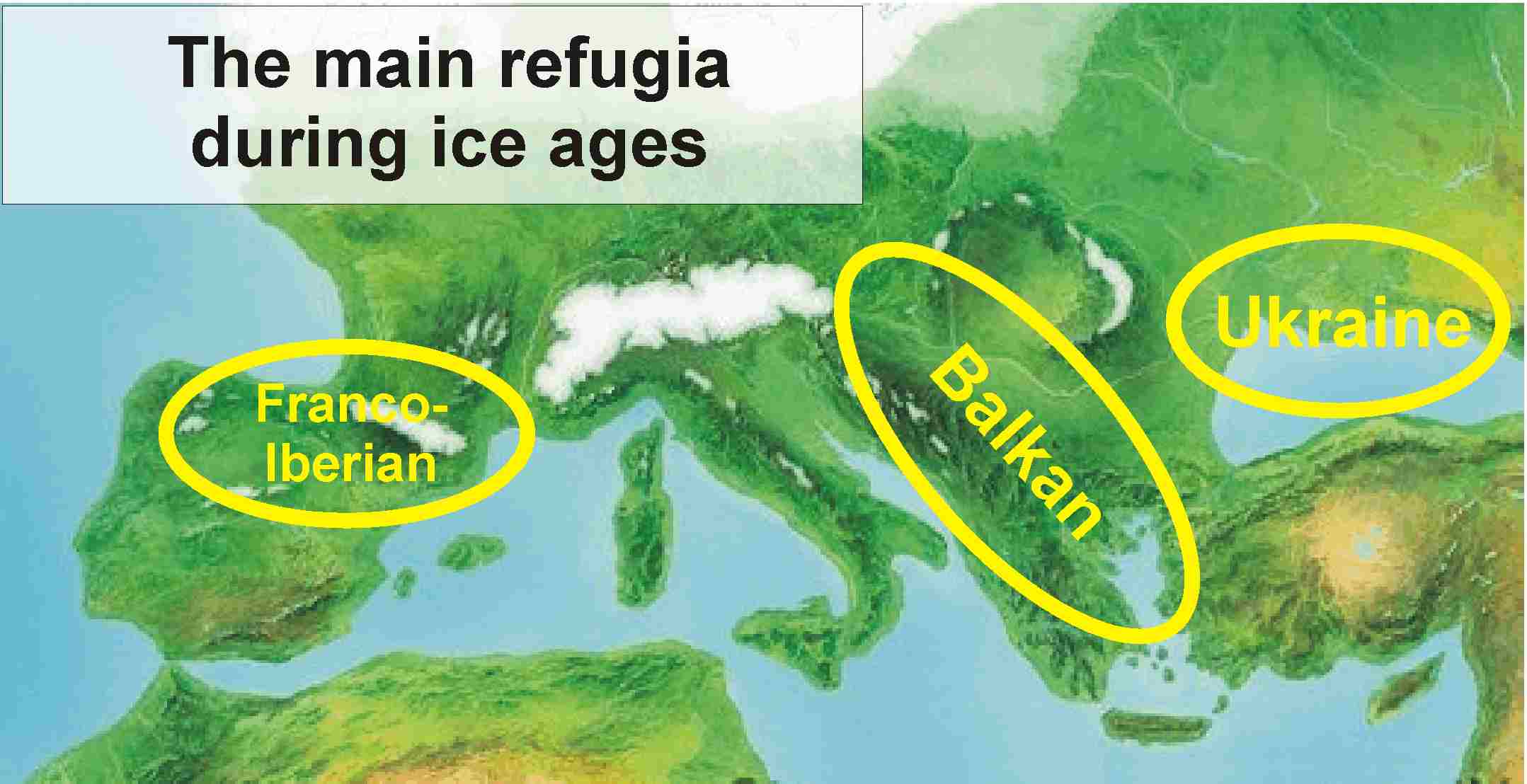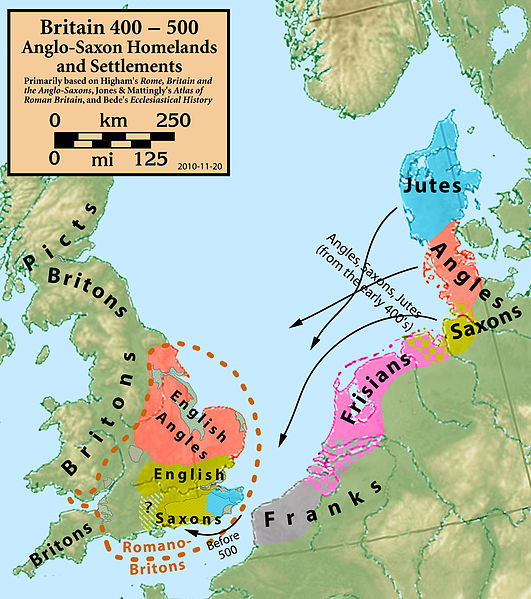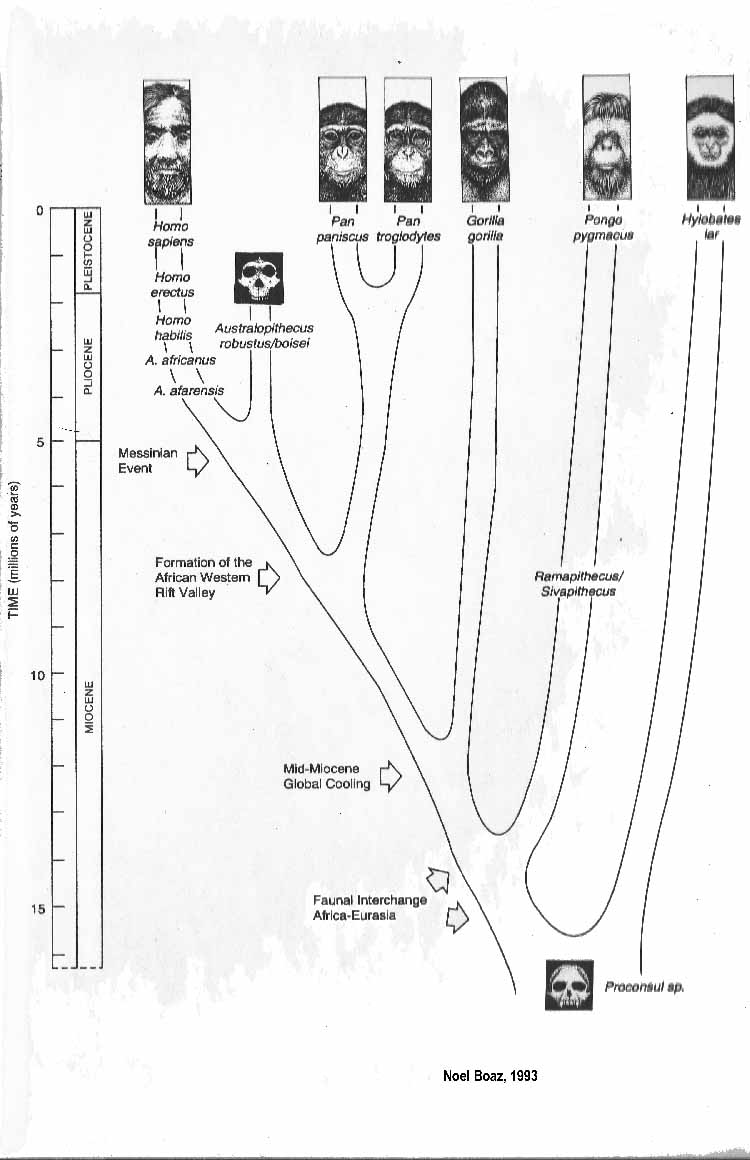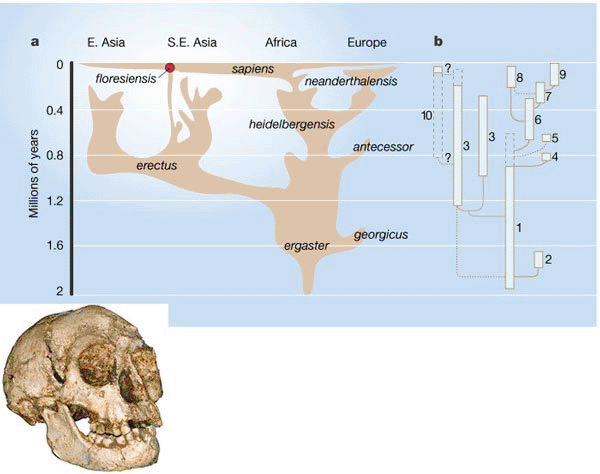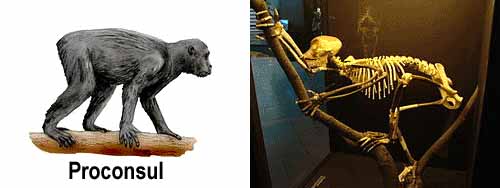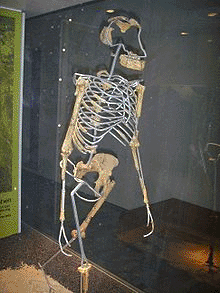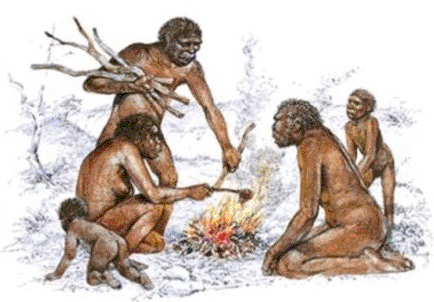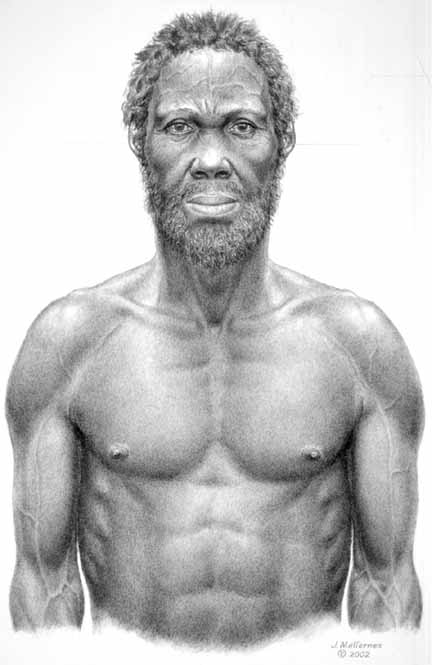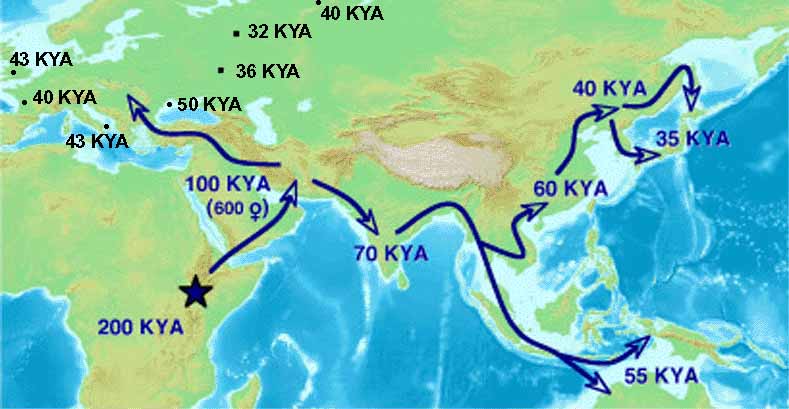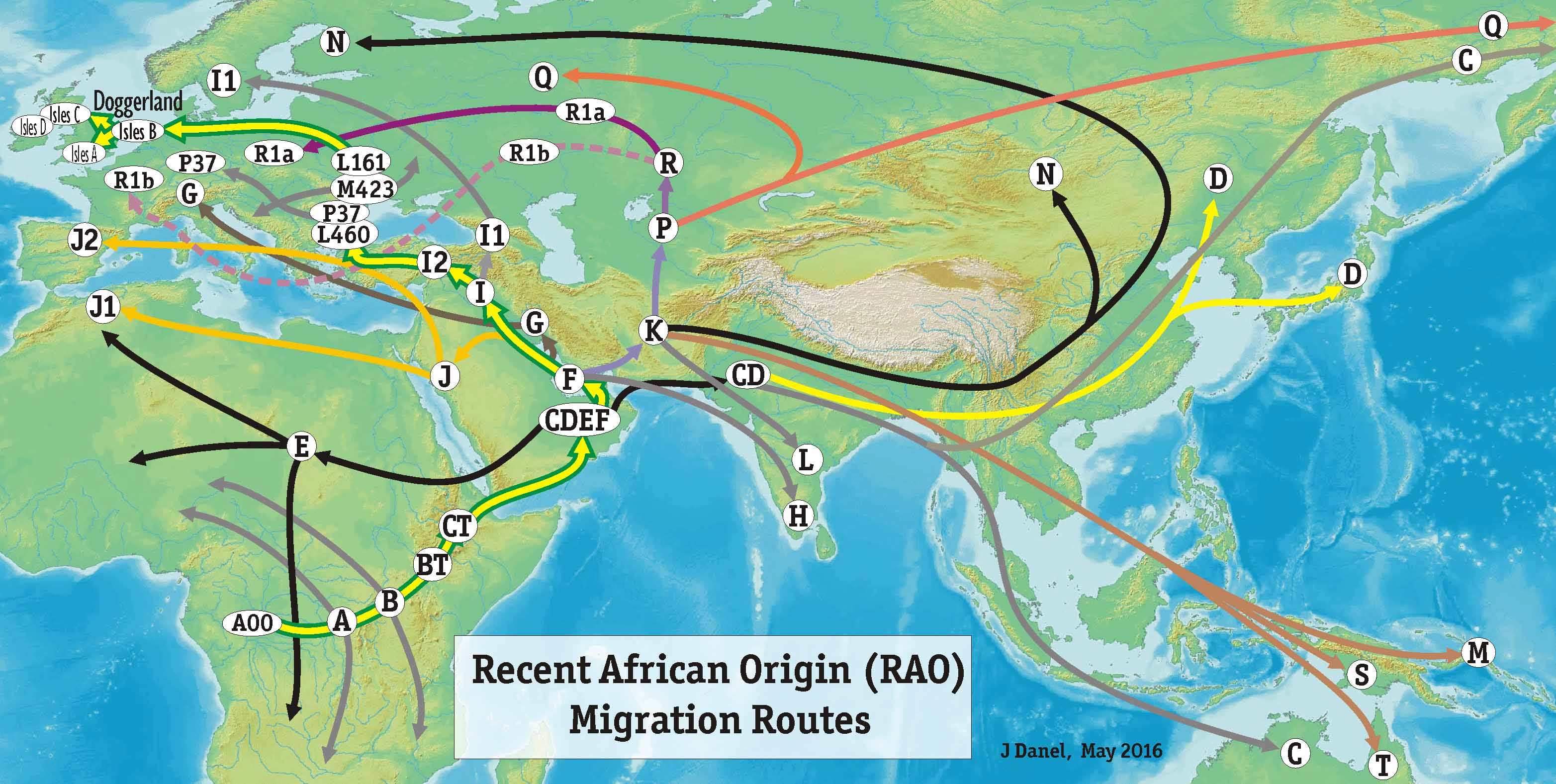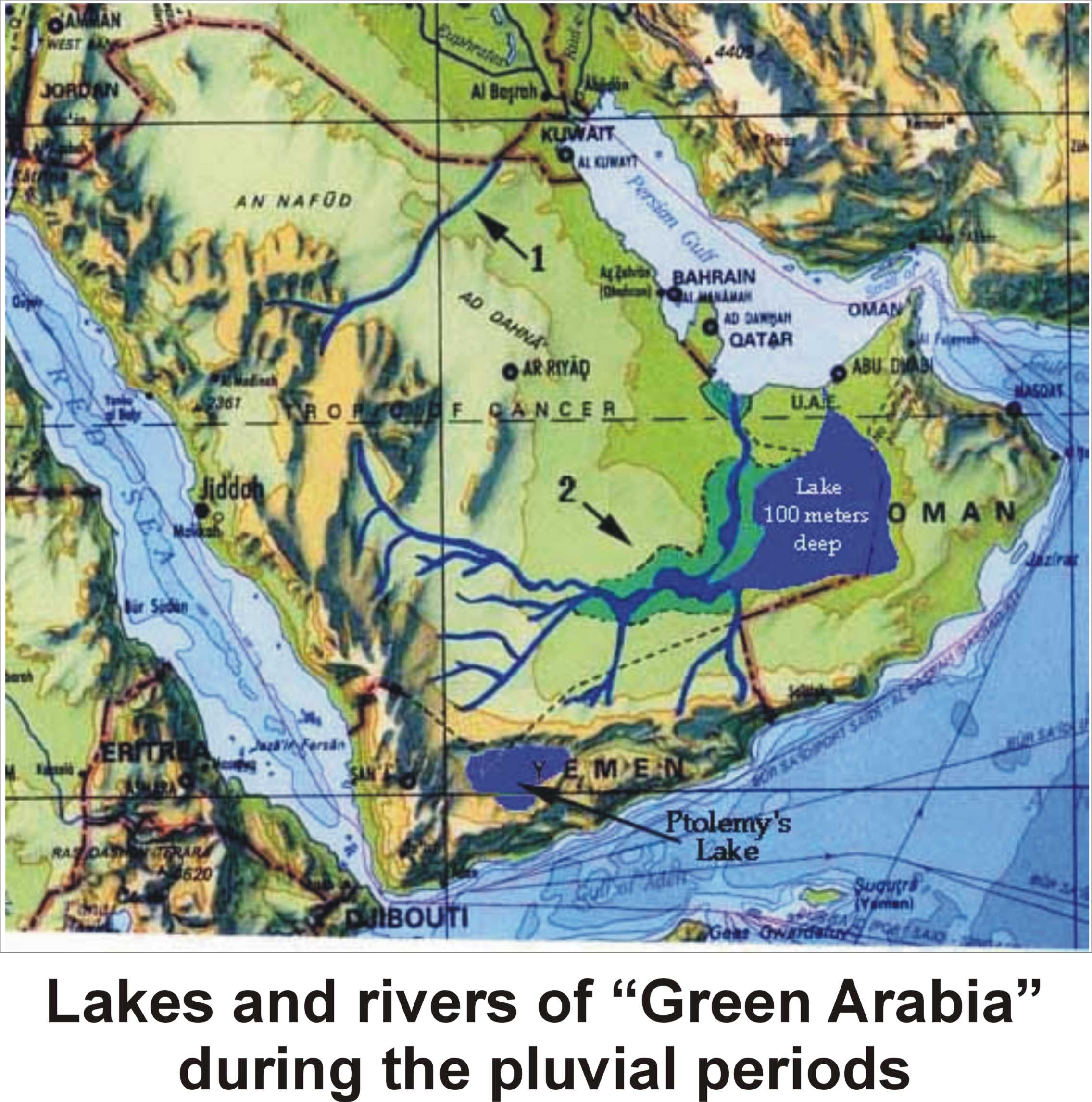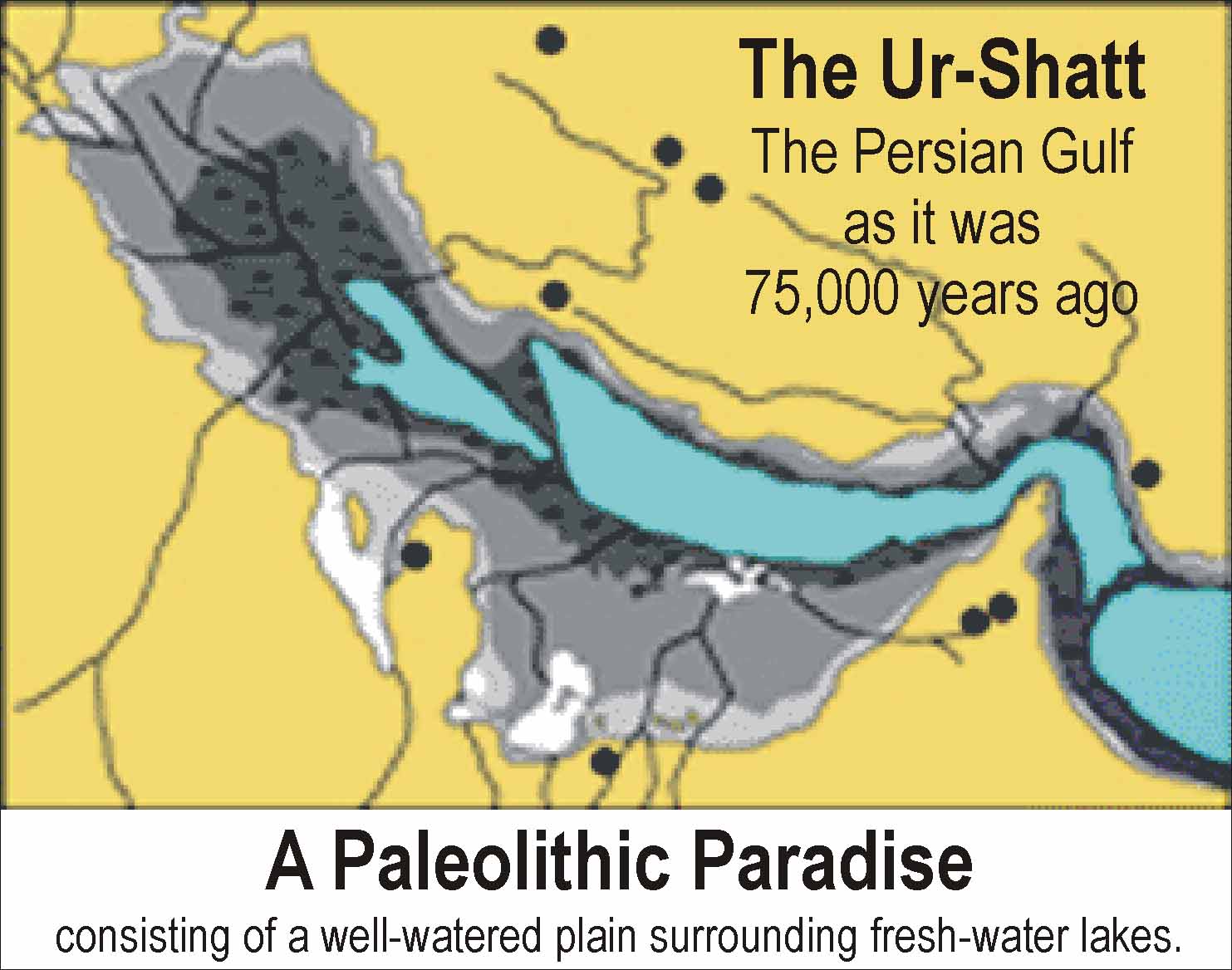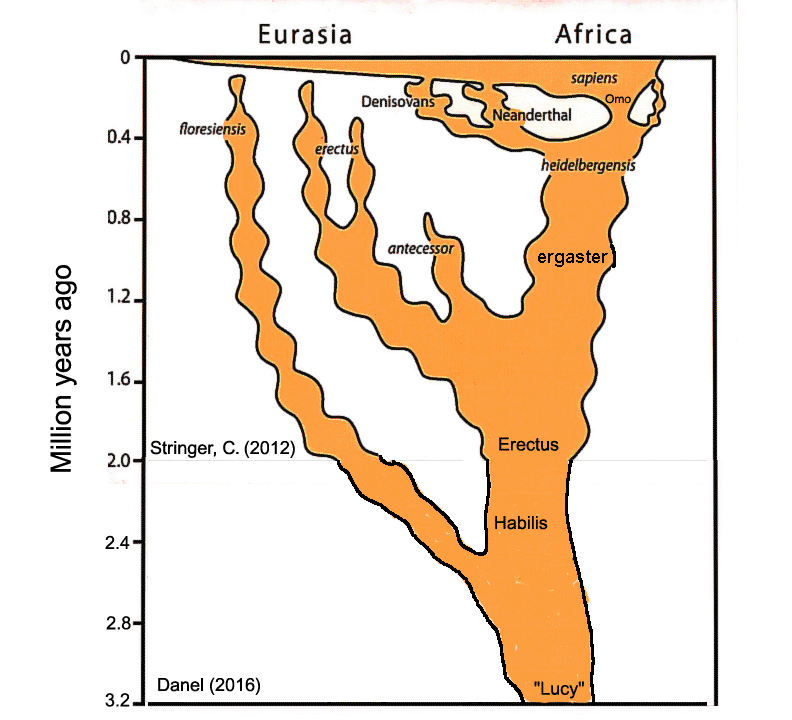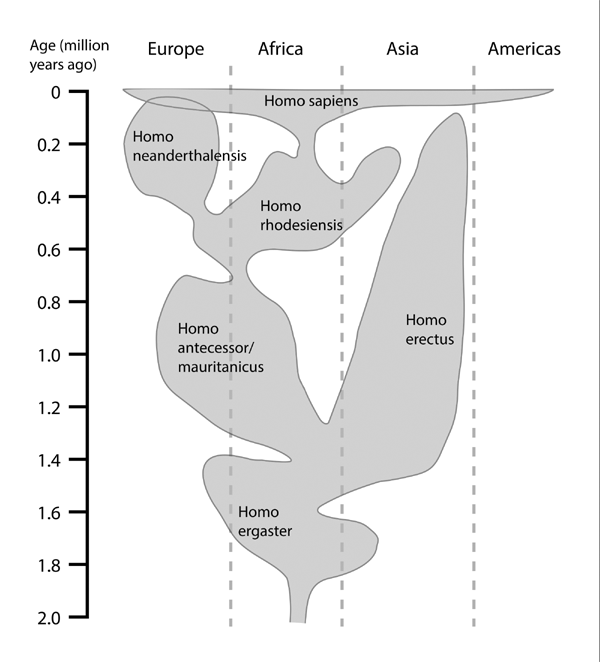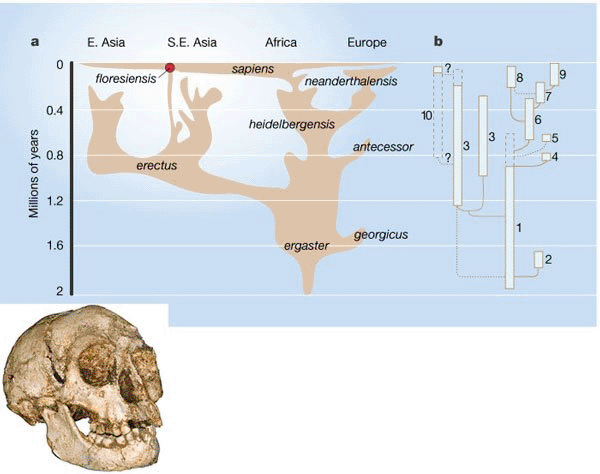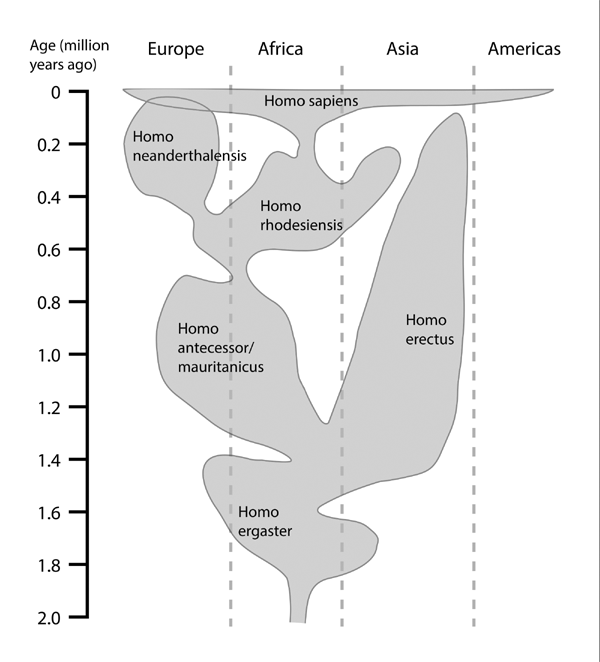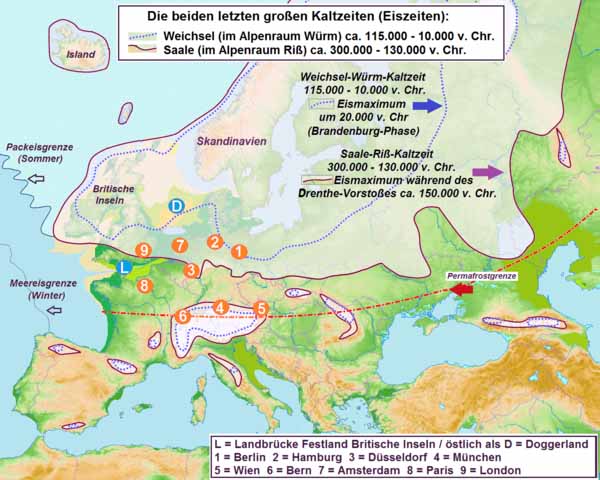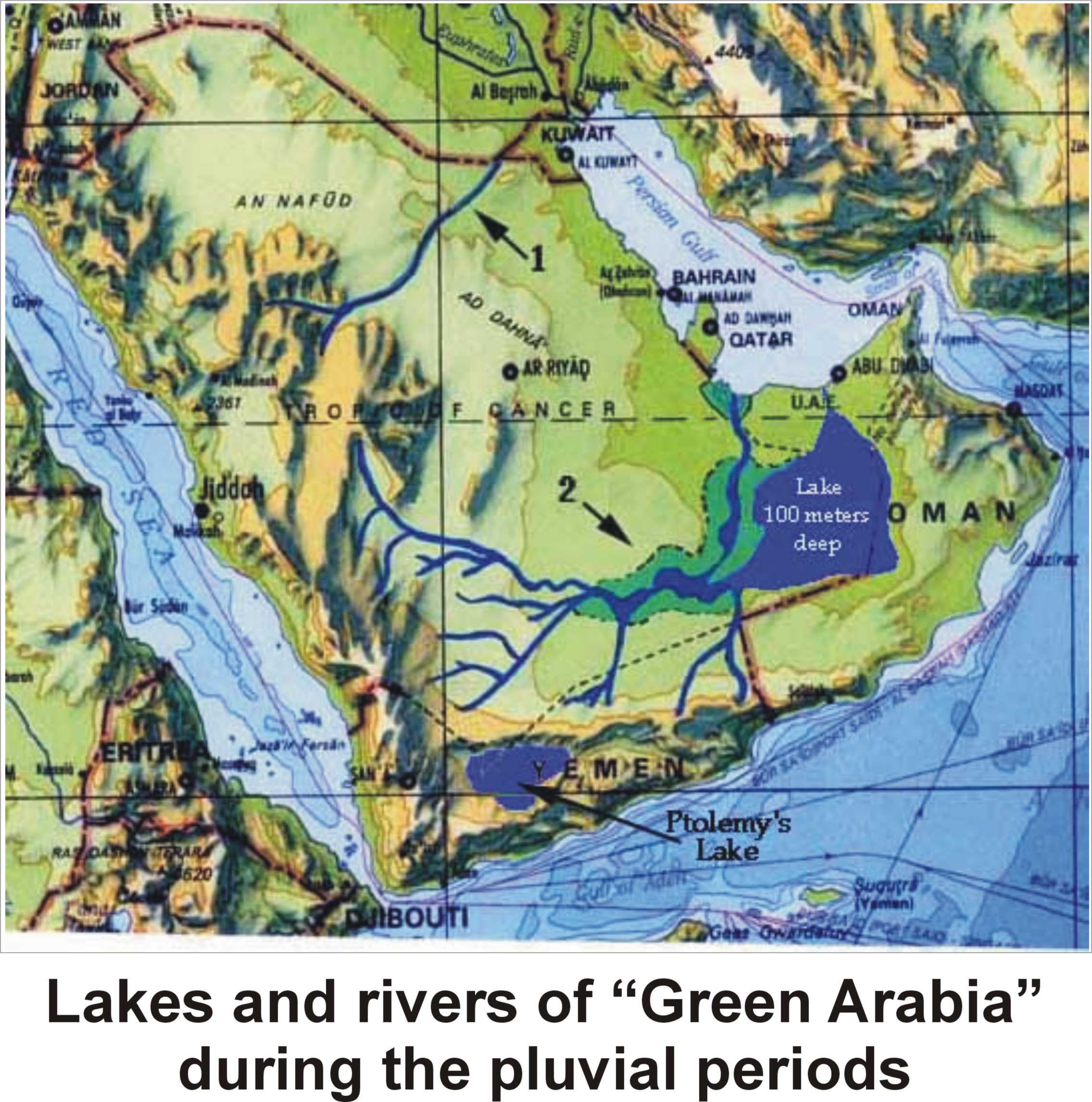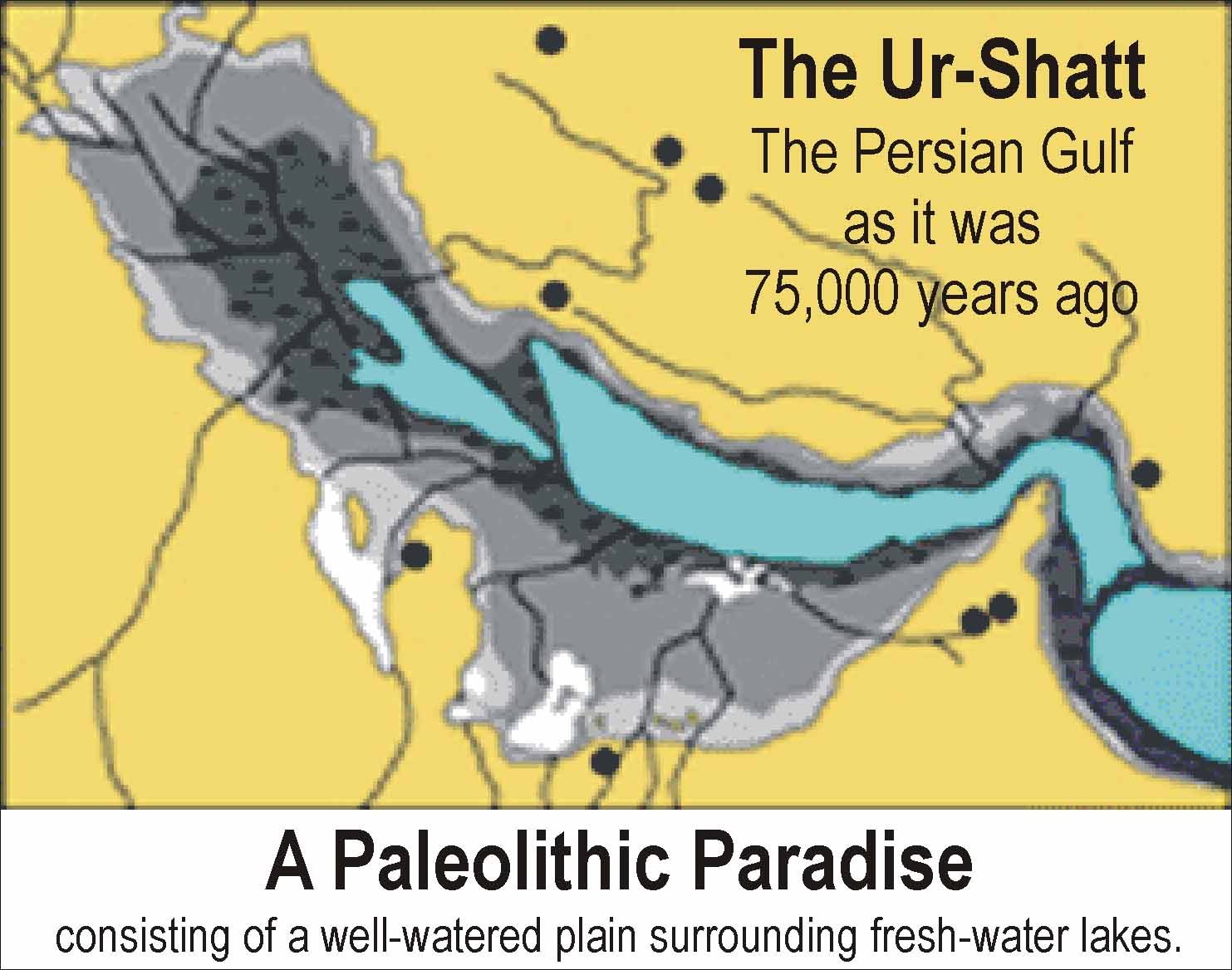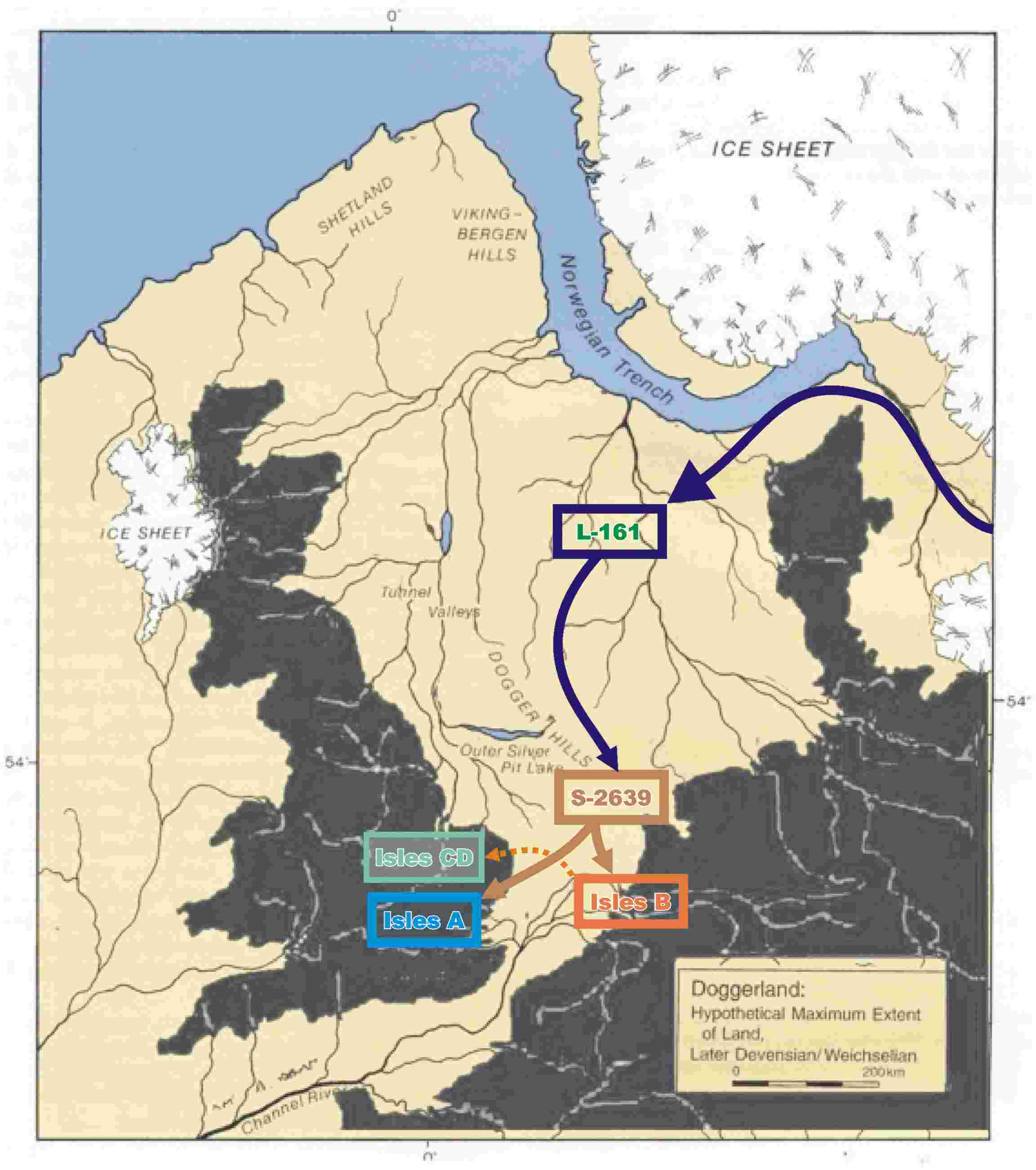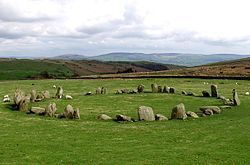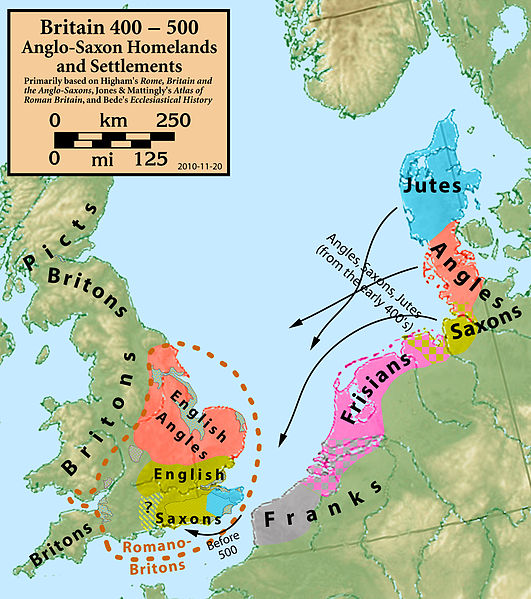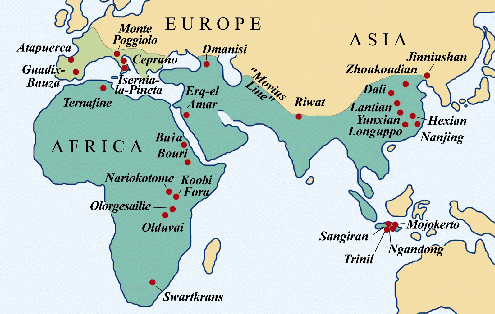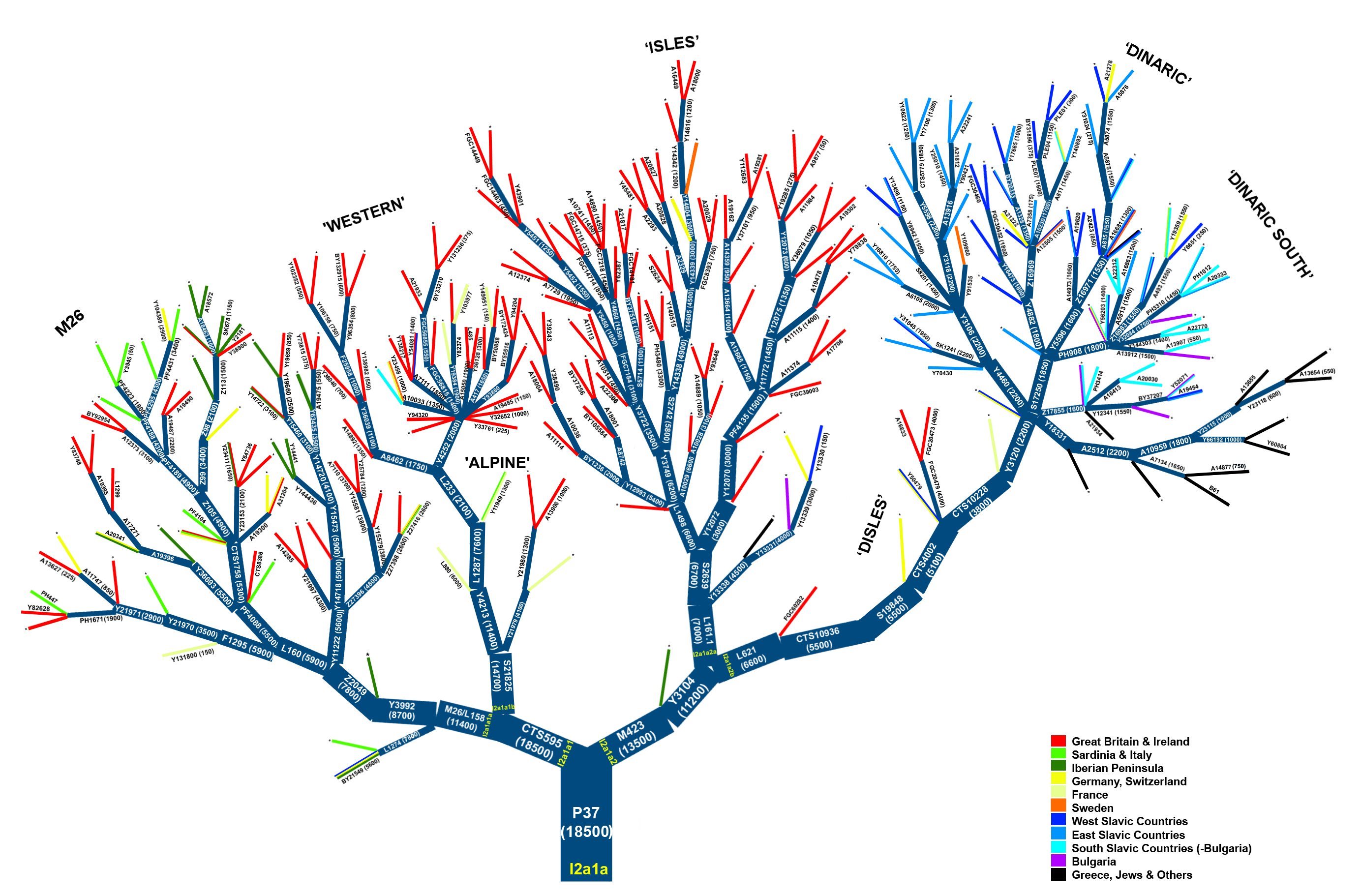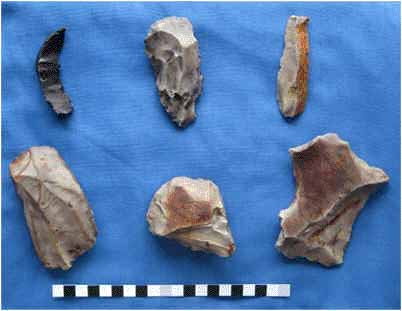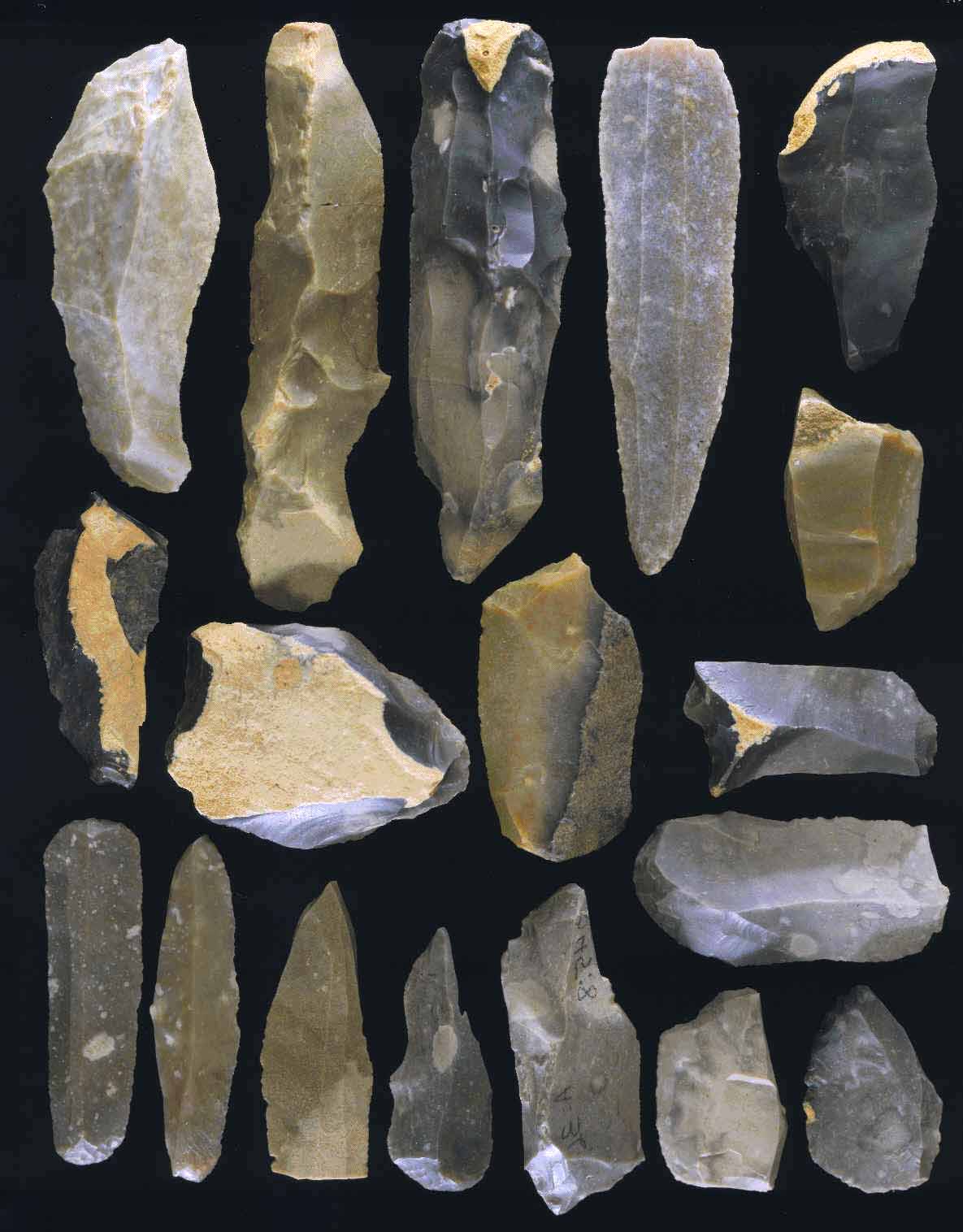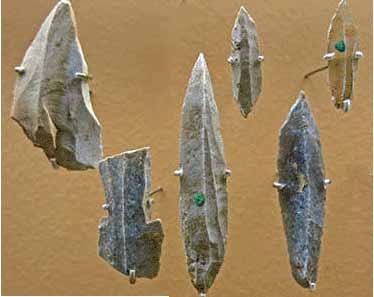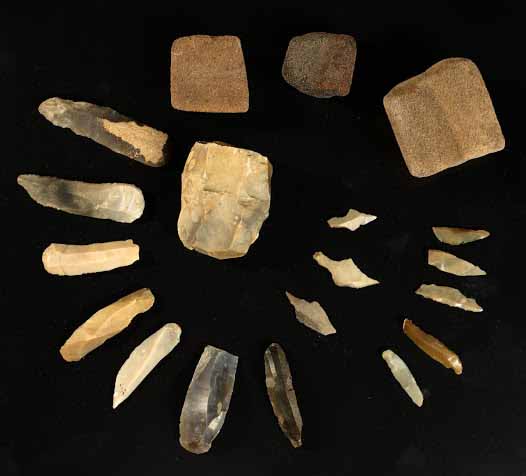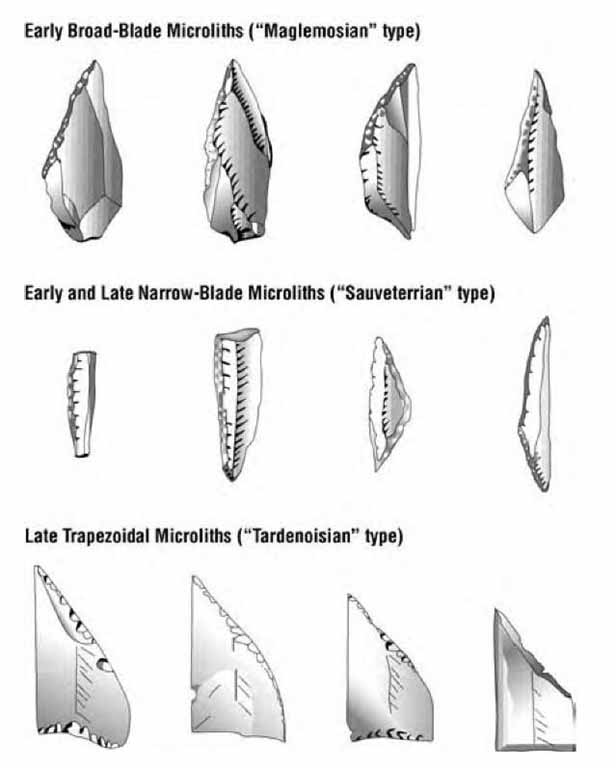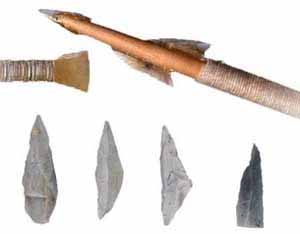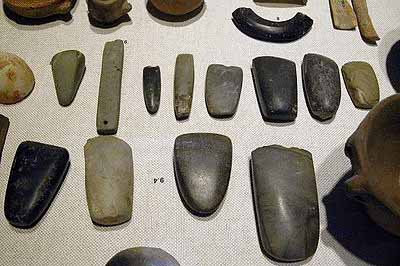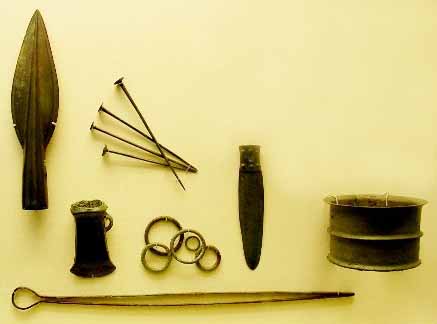
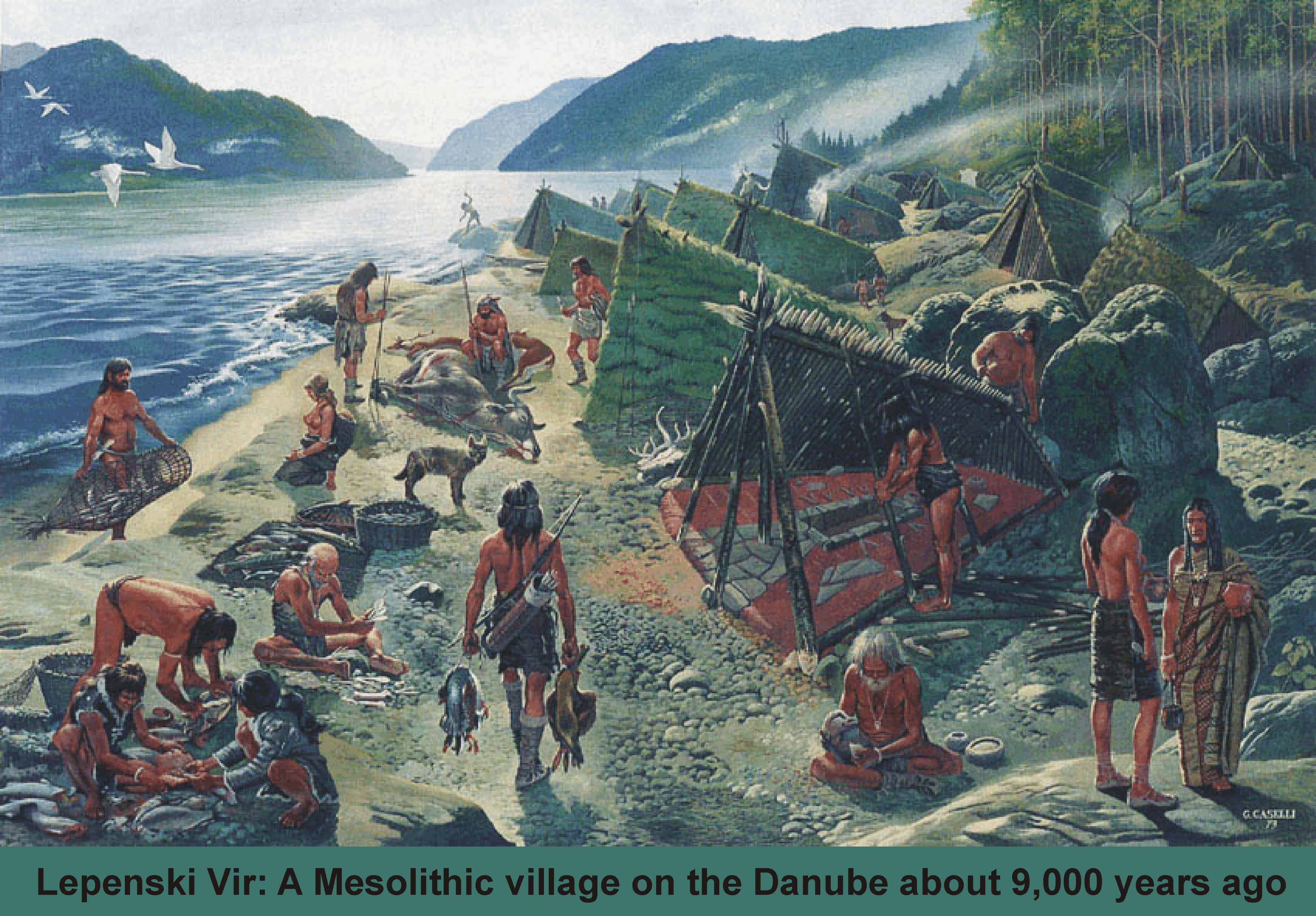
|
Haplogroup L-161
⚫ ⚫ ⚫ ⚫
The long history of DNA Haplogroup L-161.1
Isles A, Isles B, Isles C, Isles D
⚫ ⚫ ⚫ ⚫ ⚫
Tracing history from our pre-human ancestors down to the present time
A speculative extrapolation of the currently known facts
by J Danel
(ver. 2019.2)
(This is a work in progress. Please send corrections and suggestions to jack@danel.us)
----------------------- Page 2 ----------------------
Introduction
Well, Scandinavians in Britain, eh? That means Viking ancestry, doesn't it? Sorry to disappoint. While for some subgroups of Haplogroup I it may mean that, but in the specific case of L-161, probably not. The L-161 group is very small. It is less than 1% of the population in general. So how did a tiny group of Germanic ancestry get to be widely dispersed throughout Great Britain and Ireland? I will try to answer that question.
Who were these people?
The original humans began almost 2 million years ago, eventually evolving into Neanderthals in Europe, Denisovans in Asia and early humans in Africa. About 250,000 years ago, people like us emerged and thrived in Africa. Their descendants spread out into Europe and Asia until the Mt. Toba eruption changed everything.
They survived the Mt. Toba volcanic eruption
The Mt. Toba eruption was the largest in the past 25 million years. It caused a centuries long "winter" and an enduring ice age that killed almost all the humans on earth. The survivors were a few modern humans, a few Neanderthals in Europe and a few Denisovans in Asia. Some humans in Europe and Asia held on for a while, but then later went extinct. The surviving haplogroups were A, BT, and CT, all located in Africa
They migrated Out of Africa to Europe and became the Cro-Magnons
The ice age after Mt. Toba lowered sea levels enough to allow Haplogroup CT to lead a small migration Out of Africa about 60,000 years ago. The track went across southern Arabia to the Tigris/Euphrates river and the Persian Gulf. There they found a well-watered paradise. The population expanded and more haplogroups emerged:, CT led to CF which led to F which led to IJ and I. Haplogroup I migrated north re-populating Europe and interbreeding with the Neanderthals. They came to be known as the Cro-Magnons. These people produced the famous cave paintings in Lascaux, France and the "Venus" figurines found from Spain to Siberia.
They are our ancestors. We are descendants of the Cro-Magnons and of the Neanderthals.
They survived the ice ages and migrated northwest to Doggerland
The Cro-Magnons flourished until driven out of northern Europe by the Late Glacial Maximum ice age about 25,000 years ago. Some haplogroup I took refuge in Ukraine. When the ice retreated, they migrated northwest to the productive lakes and marshes in Doggerland, an area three times the size of Ireland. Sometime before or during this migration, the SNP called L-161 developed.
They enjoyed a comfortable mesolithic life in Doggerland for about 2,000 years. Then suddenly, with no warning, it was all over and most of them were dead. Three immense tsunamis wiped out most of the population in Doggerland and left it almost completely submerged. Other simultaneous events caused the climate to turn cold, sea level to abruptly rise 4 meters (13 ft.), and the food chain to collapse. There were only a few survivors. The whole catastrophe is called the "8.2 kiloyear event"
They washed up on the shorelines and spread to Ireland and Scotland
The few survivors of L-161 were split. One small group washed up on the shores of England becoming Isles A. They have remained in the British Isles ever since. Another group, Isles B washed up on the eastern shore and later migrated to Britain with the Bell Beaker folk. Isles B has since generated Isles C and D in Ireland.
Isles A, Isles C, and Isles D are found almost exclusively on the northern and western fringes of Ireland and Great Britain, while Isles B is scattered more evenly across the whole area. This paper presents an explanation for that very peculiar distribution.
That is the very brief and over-simplified history of L-161.1
For more detail, I will start much further back, with the development of a creature called Proconsul.
----------------------- Page 3 ----------------------
Table of Contents
Table of Contents
- Cover
- Introduction
- Table of Contents
- Pre-Humans
- Archaic humans
- Modern Humans
- Early migration from Africa
- Out of Africa
- Haplogroups F to I
- Cro-Magnons
- Neanderthals
- Gravettian Culture
- P37 and the Oldest Dryas
- M423
- L-161, our ancestral haplogroup
- Doggerland disaster
- Recovery from disaster
- Isles haplogroups in Albion
- The Bell Beaker invasion
- 500 years of catastrophe
- Current situation
- Climate, Culture, and Volcanic events
- Haplogroup list
- Timeline
- Tools of the cultures
- Misc Notes
- Geological Setting
- Keywords
- Proconsul apes Australopithecus Lucy
- Homo erectus H. heidelburgensis
- Omo Misliya Idaltu Qafzeh Perry
- Sinai Sahara Pump Mt. Toba
- Bab El-Mandeb Green Arabia Ur-Shatt
- Haplogroup F IJ I Cro-Magnons
- Aurignacian culture across all of Europe
- Taught Cro-Magnons DNA in modern humans
- Ice Age LGM Refugia Venus figurines
- P37-I2a1a 'Oldest Dryas' ice age Near extinction
- From Ukraine to Germany Hamburg Culture
- Maglemosian Culture Doggerland
- Floods Tsunamis Volcanos Climate change
- Isles A Isles B Neolithic transition
- Megaliths Bronze Age Isles C Isles D
- 'Ethnic cleansing' and Displacement to Ireland
- Invasions Plagues Volcanos Diaspora
- Disclaimer ISOGG SNP TMRCA FTDNA Ice Ages refugia archaeology artwork
- Chicxulub asteriod Paleoocene hot climate Azolla event
Eocene extinction meteor inpacts Oligocene cool period
Illustrations
----------------------- Page 4 ----------------------
Our Pre-Human Ancestors
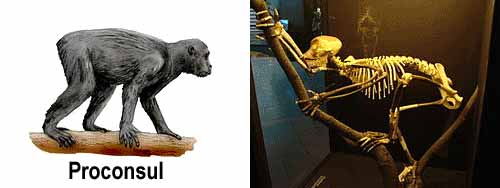 |
Our oldest known ancestor
25 million y.a., there was a small primate known as Proconsul. Agreement that Proconsul may be our oldest yet known ancestor is not unanimous, but if it was not Proconsul, it was a creature very much like it. Proconsul was very small - about 10 kg. or 22 lbs.
23 million y.a., End of the Oligocene - start of the Miocene Epoch, which extends from about 23 to 5 million years ago. It is roughly coincident with the timespan from Proconsul to the Australopicithenes.
Branching off of the apes.
Proconsul survived and evolved slowly* into larger primates. Now and then a group would branch off and go on a separate evolutionary path of their own. Monkeys had already branched off 30,000,000 years ago, long before Proconsul existed. We did not descend from monkeys.
We all descended from Proconsul or from another creature very much like him.
• 16 million y.a. - The Hylobates left, evolving into modern gibbons.
• 14 million y.a. - The Pongo group left, evolving into modern orangutans.
• 12 million y.a. - The gorillas separated.
• 7 million y.a. - The Pan group separated, evolving into chimpanzees and bonobos.
Lucy was about 1,300 mm tall or roughly four feet. Proconsul was about 300 mm tall. Evolution has very, very slowly increased the height of these creatures by about 1,000 mm over a span of 20,000,000 years. That is about
1 millimeter every 20,000 years.
5.3 million y.a.: The Pliocene Epoch extends from 5.3 million to 2.6 million years before present. It is roughly coincident with the span from H. ardipithecus and H. australopithecus (the famous fossil "Lucy", disscussed below) to Homo habilis. It was a time of global cooling after the warmer Miocene. The cooling and drying of the global environment may have contributed to the enormous spread of grasslands and savannas during this time.
5.3 million y.a.: Founding of Ardipithecus ramidus
Ardipithecus was the first bipedal hominin and the first to begin to develop language abilities.5 million y.a.: Founding of the Australopithecenes
Australopithecus generated several dead-end branches, but Australopithecus anamenis seems to have evolved into the A. afarensis that left us the famous fossil "Lucy".
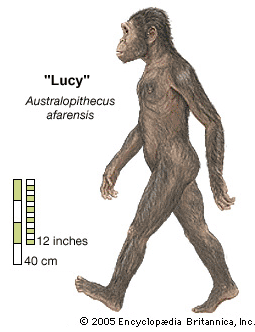
It is thought the A. afarensis lived over a wide area in East Africa. Fossils and footprints have been found many places, but the best fossils were found in the Afar Region of Ethiopia. Some of them may have used the Lomekwi culture of stone tools found near Lake Turkana, Kenya. There is debate as to whether A. afarensis is actually a different species from the preceeding A. anamensis. If they are the same, then the date is pushed back to about 5 million years.2.5 million y.a.: Australopithecus africanus lived in southern Africa.
Until recently, there has been no consensus that A. africanus is a human ancestor except for the convenient time located about halfway between A. afarensis and Homo habilis, but a very recent discovery of A. africanus fossils seems to support that placement.2.5 million y.a.: Australopithecus garhi lived in Afar, Ethiopia.
A. garhi fits neatly into a time slot located about halfway between A. afarensis and Homo habilis and is from the same area.Variations on the family tree of Proconsul's descendants may be seen here. These differ mostly as to whether Ergaster and Erectus are the same and which came first. There are others.
----------------------- Page 5 ----------------------
Archaic Humans
2.5 million y.a.: Beginning of the Paleolithic and the Pleistocene Epoch.
2.3 million y.a.: Homo habilis, an ancestor of Homo sapiens lived.
Homo habilis developed the Oldowan technology for making stone tools. Habilis lived in Africa and was possibly descended from Australopithecus africanus or A. garhi.1.9 million y.a.: Homo erectus (1.90.07 Mya) emerged in Africa and spread widely.
He was an ancestor of Homo Sapiens. This was a very successful creature surviving over a broad range in Asia (Java Man, Peking Man), Europe, and Africa for almost 2 million years until as recently as 70,000 years ago. That date suggests the Mt. Toba eruption may have had a significant role in the demise of the Erectus.1.5 million y.a.: Descendants of H. erectusDescendants of Homo habilis
• H. habilis (2.81.5 Ma),
• H. erectus (1.90.7 Ma),
• H. ergaster (1.91.3 Ma),
• H. rudolphensis (1.9 Ma),
• H. gautengensis (1.90.6 Ma),
• H. georgicus (1.8 Ma),
• H. antecessor (1.20.8 Ma),
• H. heidelburgensis (0.70.2 Ma),
• H. denisova (0.60.075 Ma),
• H. neanderthalensis (0.5-.025 Ma),
• H. rhodesiensis (0.40.12 Ma),
• H. sapiens (0.35 Ma - present),
and
• Anatomically Modern Humans, (0.27 Ma)
Undoubtedly there were many more.
Erectus developed the Acheulian stone tool technology and used it for about 1.7 million years. They used spoken language and the ability to use fire. They had dark hairless skin, rich in melanin, and abundant sweat glands that evolved about 1.2 million years ago to regulate body temperature.
We know of six more advanced species generated by Erectus during his reign. These are H. antecessor, H. ergaster, H. heidelburgensis = H. rhodesiensis, proto-neanderthals, the Red Deer Cave people, and the Omo people. Undoubtedly there were many more that are unknown.1.5 million y.a.: The Karymshina volcano in Russia erupted at a VEI 8 intensity.
It was the fourth largest eruption in the last 2 million years. It undoubtedly has worldwide effects. The thinning of the numbers of H. erectus offshoots, e.g. H. georgicus, H. rudolphensis , etc. could have been caused by Karymshina.900,000 y.a.: The Zhamanshin impact in Russia.
The largest impact in the last one million years is the 14-km Zhamanshin crater in Kazakhstan which has been described as being capable of producing a nuclear-like winter, but it was not sufficiently large to have caused a mass extinction.866,000 y.a.: Start of the Cromerian complex interglacial, a relatively warm period.
The climate was generally warm, but the period is divided into three glacials and four interglacials, which are equivalent to Marine Isotope stages 13 to 21. Before this time it becomes very difficult to determine the dates of climate events with any accuracy.800,000 y.a.: Footprints left by H. antecessor
Footprints left by a small group of people, including several children and one adult male, have been found at Happisburgh on the coast of Norfolk, England.700,000 y.a. Homo heidelburgensis or Heidelburg Man, emerged in Europe.
The ancestor of Neanderthals, Denisovans, and modern humans, developed from Erectus in Europe and lived in a wide range across Europe from England to Asia. H. heidelbergensis could hunt herd animals that can run faster than a human, and this suggests that they had sophisticated hunting strategies, a complex social structure and developed forms of communication (language ability). H. heidelbergensis therefore already had intellectual and cognitive skills like anticipatory planning thinking and acting that so far have only been attributed to modern man. Some migrated into Africa where he later developed as H. rhodesiensis. (Modern science holds that H. heidelburgensis was geographically split into the European group and into the African group which is known as H. rhodesiensis. The two names are only geographical and do not refer to a different species.) It was the European branch that developed the Clactonian stone tool technology.600,000 y.a.: Clactonian stone tool technology developed.
The European branch of Heidelburgensis improved on the Acheulean technology and developed the Clactonian technology that was later adopted by Neanderthals. Clactonian technology was used for over 300,000 years until it was replaced by the Mousterian technology developed by the Neanderthals about 160,000 years ago.500,000 y.a.: Proto-Neanderthals branched off from H. heidelburgensis.
They colonized the middle east as well as Europe and part of Asia.488,000 y.a.: End of the Cromerian interglacial stage
400,000 y.a.: Start of the Elster-Riss- Saale ice age glaciation (400 - 133 kya).
The glacial coverage of Europe was even more extensive than during the later Weichsellian ice age. The areas where London and Amsterdam sit were under deep ice. The huge amounts of water tied up in glaciers dropped sea level and caused hyper-aridity in northern Africa. Migration into and out of Africa was blocked.400,000 y.a.: H. heidelburgensis in Africa differentiated into H. rhodesiensis.
Later, modern man emerged in Africa, so the human ancestor was H. rhodesiensis.
400,000 y.a.: The Proto-Neanderthals split during the severe Saale ice age.
The western group became the Neanderthals who later shared Europe with, and learned the Clactonian stone tool technology from, Heidelburgensis. They colonized most of the colder parts of Europe that were not ice covered and parts of Asia. They survived until as recently as 25,000 years ago in southern Spain. Here is a listing and a map of the major sites.
The eastern branch of proto-neanderthals developed into the Denisovans who went on to colonize Asia (and, later, inter-breed with humans).
The timing of the division between Neanderthals and Denisovans and the extinction of the proto-neanderthals is very close to the start of the Elster-Saale glaciation. The ice pushed the populations south and split them, so then founder effect caused the separate evolution.
Homo erectus is estimated to have had an IQ of between 50 and 60, based on brain size and on tool making abilities. Modern humans have an IQ around 100. Over the past 2,000,000 years, we have gained 40 points. That is about 1 point each 50,000 years. That means we are only 6 points smarter than the early Neanderthals, 4 points smarter than the Omo people - the first AMH - and less than one single point smarter than the Cro-Magnons.
----------------------- Page 6 ----------------------
Modern Humans
280,000 y.a.: Haroharo Caldera of the Taupo volcanic zone erupts in a VEI 7 outburst, and then at 254,000 y.a. the VEI 8 of the Whakamaru eruption.
270,000 y.a.: Perry's DNA suggests Anatomically Modern Humans, abbreviated AMH, were emerging 270,000 years ago
This discovery has caused the geneticists to assign new names to the early haplogroups. Haplogroup A used to be the oldest, but now they have added A0 and A00. Haplogroup A00 probably developed from Rhodesiensis which is the same as Heidelburgensis.254,000 y.a.: Whakamaru Caldera of the Taupo volcanic zone erupts in a VEI 8, outburst.
Two enormous volcanic eruptions occurred during the timespan that includes the AMH emergence. The eruptions were in the Taupo volcanic zone of New Zealand: 280,000 years ago Haroharo Caldera (VEI 7) and 254,000 years ago Whakamaru Caldera (VEI 8). Two such enormous eruptions had worldwide effects on the flora and fauna and on the evolution of humans. The volcanic "winter", lasting decades or even centuries would have pruned the family tree back to a few especially hardy and well-situated bands, so it seems very likely that 'founder effects', the driver of evolution, could have been a major factor in the emergence of the AMH.240,000 y.a.: Body Hair gene KRTHAP1 loss occurred 240,000 years ago
220,000 y.a.: Puy de Sancy volcanic eruption in France
This very large eruption in the heart of Neanderthal country had, no doubt, dire consequences on the Neanderhal populations in Europe. This ancient stratovolcano has become the highest mountain in the Massif Central of France.195,000 y.a.: The Omo people were living in Africa.
Fossils 195,000 years old have been found at the Omo Kibish site in Ethiopia, the oldest AMH fossils found so far. Eventually it may be proven that these the founding Haplogroup A0 fossils. (Perhaps there should be a term Homo Omo for these people).190,000 y.a.: The first(?) of several migrations of modern humans from Africa
They took the northern route across the Sinai. These modern humans colonized much of Eurasia during several of the long wet periods in the 20,000 year long North African climate cycle, leaving fossils that present intriguing questions about interbreeding and development of these early modern humans.185,000 y.a.: Modern(ish) humans were living in Misliya cave near Haifa, Israel.
160,000 y.a.: Homo sapiens idaltu, modern humans, developed.
The fossilized remains of H. s. idaltu were discovered at Herto Bouri near the Middle Awash site of Ethiopias Afar Triangle.160,000 y.a.: Neanderthals develop the Mousterian industry in Europe 133,000 y.a.: End of the Saale ice age. Beginning of the Eemian Interglacial Warm Period.
These specimens are argued to represent the direct ancestors of modern Homo sapiens sapiens. They were AMH - Anatomically Modern Humans. They were not the knuckle-dragging stereotypes of 'cavemen', but were esentially just like us. There were some differences in their bones, their skin was brown, blonds were very rare, and blue eyes did not exist.
Founded as Haplogroup A, continuing diversification of the gene pool led them through the sequential development of Haplogroups A1 and A1b.
The climate was warmer than the current climate. Forests reached as far north as Cap Nord, Norway and Oulu, Finland. Sea level rose 20 to 30 feet higher than today.133,000 y.a.: Start of the Abbassia Pluvial wet period in the Sahara
It was a wet period that caused the Sahara and the Sinai to bloom with lush vegetation fed by lakes, swamps, and river systems. This unblocked the route north out of Africa. The route stayed open for 30,000 years. These wet cycles occurred several times and are the basis of the "Sahara Pump Theory" about how the earlier people were able to cross what is now a very harsh route out of Africa several times in relative comfort.130,000 y.a.: Migration of humans from Africa began via the northern route.
The track was across the Sinai which was also benefitting from the Abbassia Pluvial wet period. These modern humans colonized much of Eurasia during the 30,000 year long wet period. Fossils have been found at the Qafzeh and Es-Skhul sites near Nazareth and Haifa in Israel and at Jebel Faya near Dubai dating to about 120 kya. They were probably Haplogroup A1 or A1b or even older haplotypes. The route stayed open for 30,000 years until the Weichselian ice age changed the global climate. Then the Sahara reverted to desert as a result of the retreat of the West African Monsoon southwards. The desert again blocked the northern route out of, and into, Africa. The Qafzeh/Es Shkul hominids had died out by 80 kya because of drying and cooling conditions of the Weichselian ice age.115,000 y.a.: The " Last Glacial Period ", the lethal Weichselian Ice Age began its advance.
This long, extremely severe ice age drove all of the human settlements of the various earlier "Out of Africa' migrations to extinction. They left fossils, tools, and archaeological evidence, but no known surviving descendants except for perhaps a few hybrid Neanderthals in Europe and, in Asia, some Denisovans and H. erectus groups.Meanwhile, back in Africa:
115,000 y.a.: Haplogroup BT emerged from Haplogroup A1b.
100,000 y.a.: Haplogroup CT evolved from Haplogroup BT
----------------------- Page 7 ----------------------
Early Migrations from Africa and the
Mt. Toba catastrophe
The early migrations of modern humans from Africa were complete failures.*
There were probably many early migrations out of Africa - Misliya, Qafzeh, Es-Skhul, Jebel Faya, and others yet undiscovered - but they all eventually failed. The extremely severe Weichselian ice age and the Mt. Toba eruption exterminated all the earlier migrants. They left fossils and archaeological sites, but no descendants except a few hybrid Neanderthals, Denisovans and a few Homo erectus.
Beginning about 200,000 years ago small groups of Idaltu type people - Haplogroups A, A1, and A1b - began to find a way out of Africa. They moved out on the northern route across the Sinai as suggested by the "Sahara Pump Theory". The warm, moist conditions of "Abbassia Pluvial" type climate periods made that area much less formidible than it is today. It is not known whether the climate changes triggered the movements or just made it possible. These small migrations continued for at least 130,000 years. They spread to India and on to southeast Asia by 80,000 years ago.
The competition and the struggle for survival may have been fierce and deadly. The space they were moving into was occupied by several varieties of genus Homo entrenched there, in some cases, for more than a million years. Homo Erectus still thrived, as did Heidelburgensis, Neanderthals, and Denisovans.
Mega-fauna as food sources included: woolly mammoth, steppe mammoth, straight-tusked elephant, aurochs, steppe bison, Irish elk, equus, and Elasmotherium, but these are all large and dangerous to hunt with just primitive weapons such as spears and clubs.
There were dangerous predators that hunted the migrants. These included: wolf, cave lion, cave bear, cave hyena, saber-toothed tigers, and giant polar bears among others. Other hazards would have included a new assortment of deadly germs, poisonous plants, insects, and snakes.
and then things got very much worse.
It is known in Europe as the Weichselian Ice Age. This long, severe ice age drove all of the human settlements of the "Out of Africa' migration to extinction.Meanwhile, back in Africa:
As the 'abbassia pluvial' was phasing out and the ice age was phasing in, Africa experienced hyper-aridity because of the change in the monsoon flow and low sea levels because the water was tied up in glaciers.
115,000 y.a.: Founder effects caused by the hostile climate may have resulted in Haplogroup BT emerging from A1b.
100,000 y.a.: Haplogroup CT evolved from Haplogroup BT
100,000 y.a.: Hyper-aridity enlarged the Sahara and blocked the northern route out of and back into Africa.
Mt. Toba catastrophe
It was the largest volcanic eruption of the last 25 million years
75,000 y.a.: The Mount Toba eruption
A vast amount of ash and noxious gases (six gigatons of sulfur dioxide and 3,000 cubic kilometers of rock) were emitted, causing extinctions of food sources and centuries of famine.
It was followed by a thousand year long cold period.
The Mt. Toba catastrophe had major effects, not just in the near-extinction of the modern humans, but also on the populations of Homo Erectus. Homo Heidelburgensis, Neanderthals, Denisovans and other inhabitants of Asia and Europe. It may have been the final cause of the extinction of Homo Erectus and others of these groups.
One ironic effect was that the populations of the large predators - saber-toothed cats, cave bears, etc. - were sharply reduced. Some went extinct. The smaller prey animals were also reduced, but in the new low-predator environment they rebounded quickly. Plants also quickly rebounded, taking advantage of the soil improvement by the volcanic ash. Food was abundant and the competition was low, allowing the following "Out of Africa"* migration to be resoundingly successful. Haplogroup CT, migrating from Africa, found itself to be the new 'Top Predator' in the new low-competition environment of southwest Asia.
Repopulation of Asia and Europe began with the descendants of Haplogroup CT.*
* The "Out of Africa" or "Recent African Origins (RAO)" hypothesis.
----------------------- Page 8 ----------------------
Out of Africa
70,000 y.a.: The main migration Out of Africa began via the southern route. The much lower sea levels, as much as 200 feet lower, during this time allowed the small groups to cross the Bab el-Mandeb Strait to Arabia.
The early migrants were mainly Haplogroup CT. Several new groups quickly emerged and diverged from CT to become extremely successful in the bountiful enviroment:The much lower sea levels, as much as 200 feet lower, during this time allowed the small groups to cross the Bab el-Mandeb Strait to Arabia. Then they travelled through the warm and verdant "Green Arabia" or they followed the coastline eastward to the Persian Gulf and the Indus river. These modern humans colonized much of southern Asia.Migration
Out of Africa
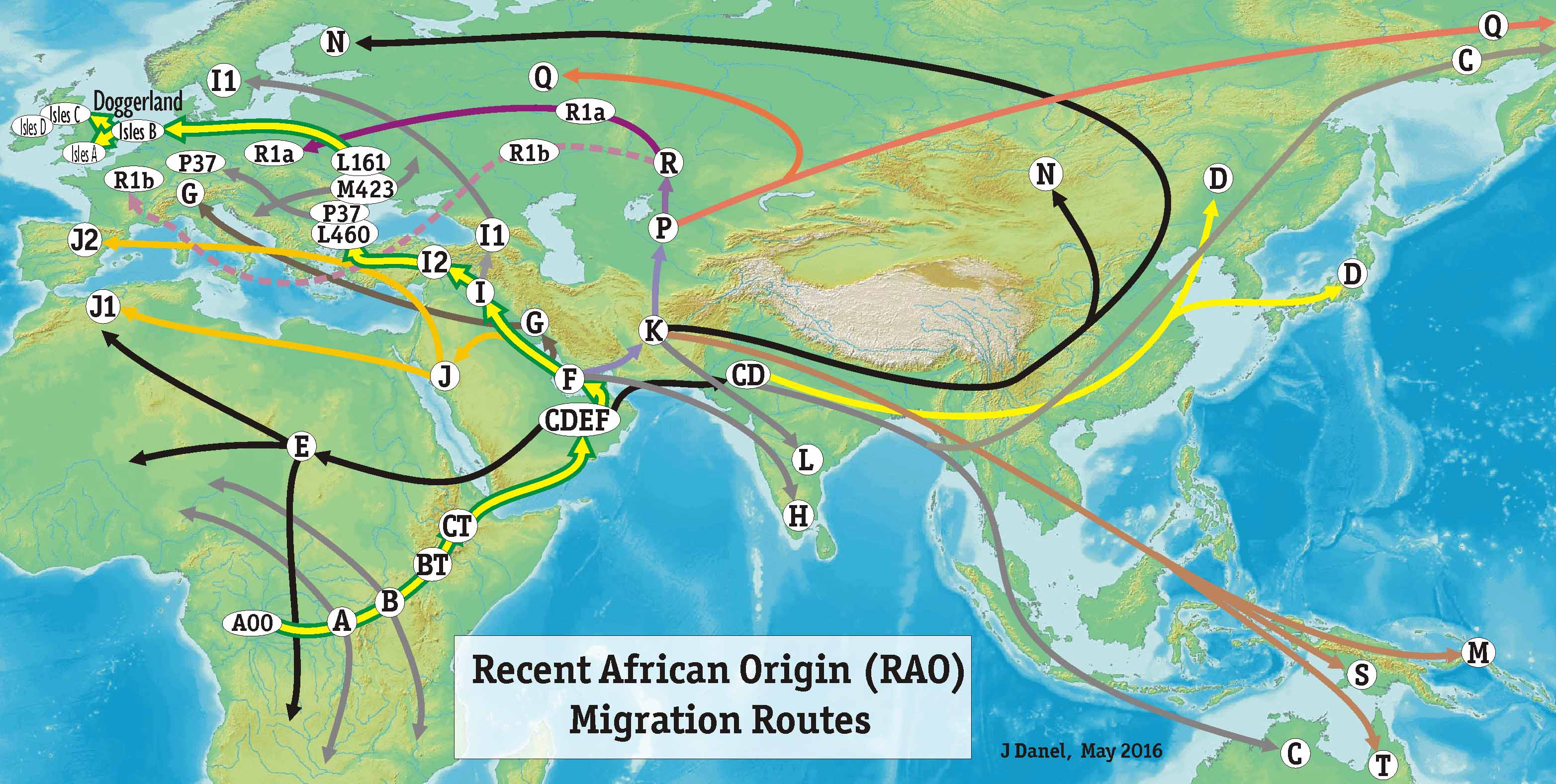
|
----------------------- Page 9 ----------------------
Haplogroup F
65,900 y.a.: Haplogroup F, emerged from Haplogroup CF.
Haplogroup F probably developed in the Tigris/Euphrates delta in the Persian Gulf or perhaps in the Indus River delta. In that part of the Weichselian ice age, the sea level was much lower, so the Persian Gulf was dry land to the south past the Strait of Hormuz. The area is sometimes known as the Ur-Shatt, or old Shatt river valley. The area was a well watered plain surrounding fresh-water lakes. There were abundant resources to support hunter-gatherers.
(SNP M89, defines Haplogroup F).
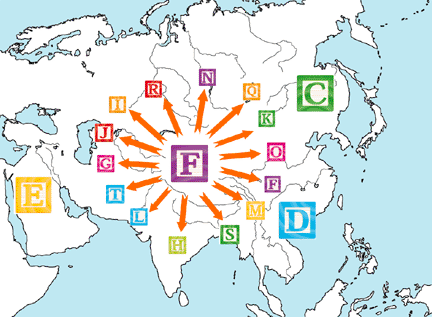
|
----Haplogroup F was very successful. Many small groups formed and migrated outward following the coast and the rivers. These groups evolved into 14 of the main haplogroups known today. Haplogroup F is ancestral to about 90% of non-African men worldwide. |
This "Grandfather's Path" graphic illustrates the route followed by the ancestors of L161 from the time Haplogroup F occupied the Persian Gulf about 65,000 years ago.
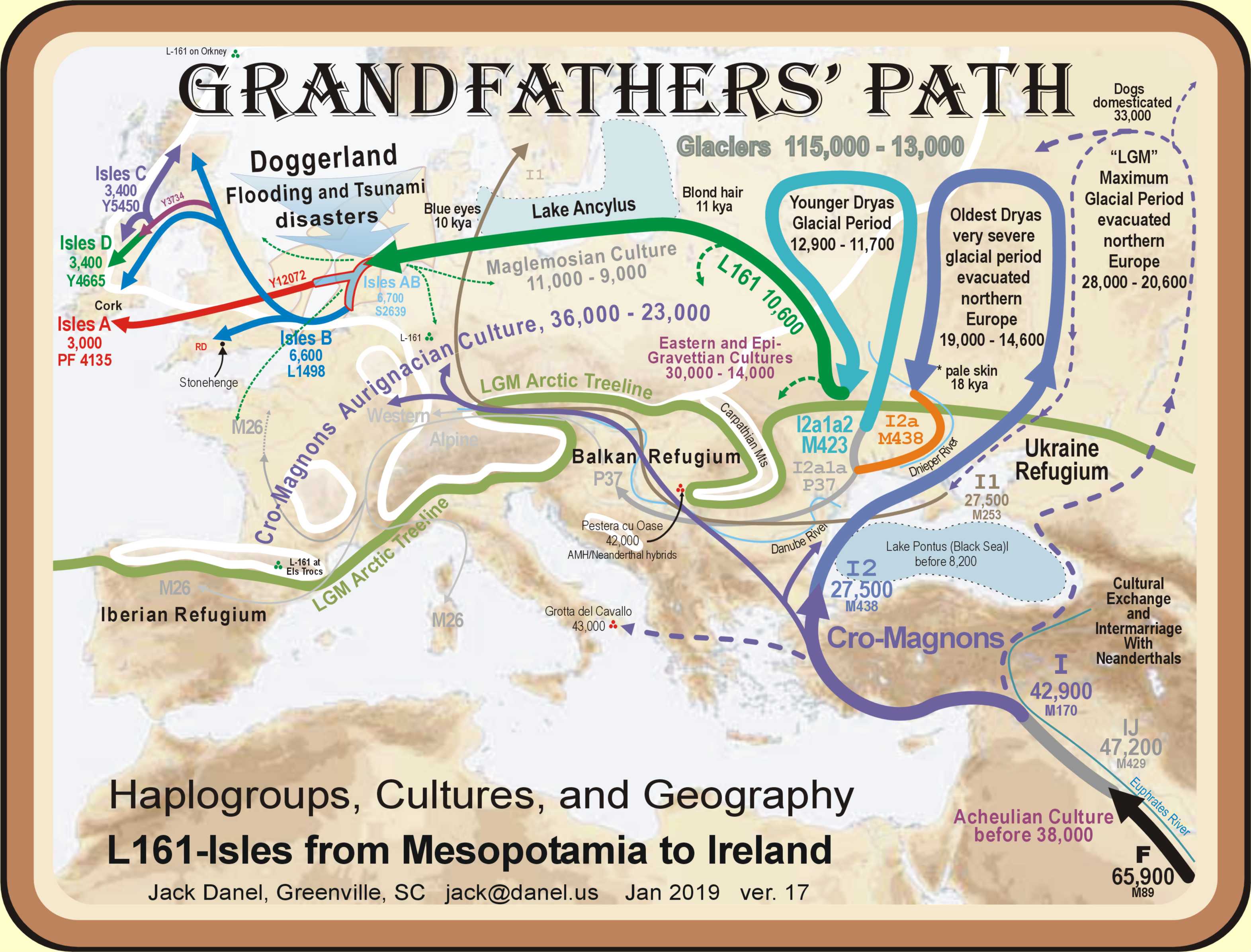
55,000 y.a.: Haplogroup F, diverged through stages to Haplogroup IJ
Haplogroup IJ was located somewhere in the northern end of the huge area occupied by Haplogroup F. Considering the dry climate, water resources would have been critical. They would have found good conditions in the area between the Tigris and Euphrates, now known as Baghdad. Groups G, H, and K branched off and are not ancestors of L-161.50,000 y.a.: The Mousterian Pluvial warm wet climate period began.
50,000 y.a.: The Glinde and Moershoofd Interstadial warm climate period begins.
Including the following Hengelo and Denekamp warm periods, there was a span of about 20,000 years of mostly good weather. Haplogroup I made good use of the time to repopulate most of Europe.
Haplogroup I
45,000 y.a.: Haplogroups I and J split from IJ in Persia or Kurdestan.
The group that would become Haplogroup I went north and split going around both sides of Lake Pontus, the Black Sea in a fresh water phase. From there they re-populated Europe during the 10,000 year long Glinde-Moershoofd warm period. The timing was from from 50,000 to 39,400 years ago. (J spread from Kurdestan mostly to the south and west, populating the entire eastern and southern Mediterranean region.) There are still significant populations of subgroups of I and J remaining in Kurdestan. Here is a link to a map of the modern distribution of Haplogroup I. Kurdestan is at the lower right. (SNP M170 defines this group and is the key marker for the expansion of Cro-Magnons in Europe.)
----------------------- Page 10 ----------------------
Cro-Magnons
45,000 y.a.: Cro-Magnons, an early group of Haplogroup I, colonized Europe.
The distribution maps suggest that Haplogroup I1 - M253 went to the east of the Black Sea to the far north and then were driven back south (up the Rhine, down the Danube) into the Balkan Refugium by the return of the ice about 28,000 years ago.
L-161 ancestors, the Cro-Magnons of Haplogroup I2- M438, went west of the Black Sea and north to the area that is now Ukraine and Moldova. From there, they populated most of Europe.
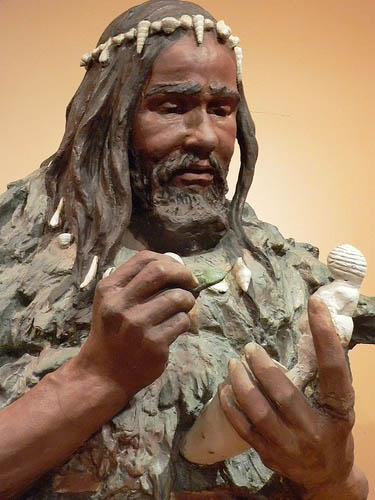
Cro-MagnonCro-Magnons were just like usexcept the genes for blond hair [11 kya], blue eyes [10 kya] and pale skin [18 kya] had not yet developed. |
The term Cro-Magnon does not have a real definition and has fallen out of favor. It is used generally to refer to Anatomically Modern Humans (AMH) or Early European Modern Humans (EEMH) with the SNP M170 dna marker using the Mousterian or Aurignacian technology before the Gravettian technology was developed about 30,000 years ago. They were not the stereotypical knuckle-dragging cave men. Their brain capacity was about 1,600 cc (98 cu in), which is larger than the average for modern humans
50,000 y.a.: Cro-Magnons began arriving in the Caucasus where they met and mixed with Neanderthals. By 43,000 years ago, they had gone all the way to England.
Archaeological evidence left by Cro-Magnons is spread over the entire continent:
43,000 y.a.: Grotta del Cavallo in Liguria Italy.39,400 y.a.: The Huneborg Stadial ice age or cold period began and lasted over 5,500 years.
43,000 y.a.: Kent's Cavern in England
42,000 y.a.: Pestera cu Oase cave in Romania .The cave is near the area of Lepenski Vir which is on the Serbian shore of the Danube. (The painting of Lepenski Vir at the top of the page is near the 'Iron Gates' on the Danube.) The fossils in this cave show admixture with Neanderthals up to 50%.40,000 y.a.: Mamontovaya Kurya in the Russian Arctic.
38,000 y.a.: Cro-Magnons developed the Aurignacian stone tool technology. In many of the locations, there was evidence of occupation by both Cro-Magnons and Neanderthals, though perhaps at separate times.
33,000 y.a.: Cro-Magnons domesticated dogs in Russia at the Kostyonki site.
32,000 y.a.: Cave paintings dating from the Aurignacian at Chauvet Cave in France.
and many others.
During the various ice ages, the conditions in northern Europe were too severe for primitive people to survive. They either died or were able to retreat to the south into areas of better climate. There were three such areas called "refugia": (1) the Ukraine refugium around the Black Sea, (2) the Balkan refugium along the Danube River and the Dalmatian coast, and (3) the Franco-Iberian refugium in Cantabria and the Aquitaine. Italy is blocked off by the Alps and so could not effectively function as a refuge. Further east was the Siberian refugium, but it is geographically reemoved trom our subject.39,000 y.a.: Campi Flegrei caldera volcano near Naples Italy erupted as a VEI 7.
A decade of extreme cold weather as a result of the dust cloud may have been significant in the extinction of the Neanderthals. It was the biggest volcanic eruption in Europe in the last 200,000 years. (The Mt. Toba, 75 kya, and Mt. Thera, 3.5 kya, eruptions were much larger but were outside Europe).
----------------------- Page 11 ----------------------
Neanderthals
When modern humans first encountered Neanderthals, it was the Neanderthals who had the advanced culture and the modern humans were the more primitive.
The Cro-Magnons coming to Europe were using the very ancient Acheulean technology developed by Homo Erectus. The Neanderthals had developed and were using the more advanced Mousterian technology. After a few thousand years, the Cro-Magnons had learned the Mousterian from the Neanderthals and then used it for the next several thousand years. Eventually the Cro-Magnons improved the Mousterian developing the Aurignacian technology from (very roughly) 38,000 to 29,000 years ago and taught it to the Neanderthals. The Cro-Magnons spread the Aurignacian all across Europe.
Neanderthals and Cro-Magnons shared Europe for less than 20,000 years. The estimates of total Neanderthal population vary from as many as 70,000 to as few as 3,000.
50,000 y.a.: Neanderthals inter-bred and probably inter-married with Cro-Magnons
Besides cultural exchange, things were sometimes more personal. DNA shows there was significant inter-breeding with Neanderthals near the Caucasus and all across Europe about this time. The result is that present-day humans of European stock have 1-4% Neanderthal DNA.45,000 y.a.: Neanderthals taught the Mousterian to the Cro-Magnons
We seek to understand how these two activities - the teaching of technology and the DNA exchange - happened. A number of suggestions have been made - rape, kidnapping, etc., but none of these would provide enough DNA to get to 4%. One reasonable explanation is that they may have been a result of exogamous, patrilocal marriage practices generally used by hunter-gatherers, including (as shown by archaeology, DNA studies, and the strontium ratios in Cro-Magnon female bones) the Cro-Magnons and Neanderthals. In this situation, Neanderthal brides would marry Cro-Magnon men and bring their knowledge of the Mousterian with them to live with their husband's family and teach them the better methods, and then the reverse. This was how the Cro-Magnons first learned the Mousterian and also how the Neanderthals later learned the improved Aurignacian technology. This hypothesis provides a workable mechanism for the cultural and DNA exchanges to have taken place.
38,000 y.a.: Cro-Magnons developed the Aurignacian technology.
The Neanderthals had developed the Mousterian technology and, in western Europe, were improving on it: there were localities in France using the advanced Chatelperronian and, in Italy, Uluzzian methods. These advanced styles did not spread significantly indicating isolation of the Neanderthal groups from each other. These advanced tool styles were far ahead of anything the Cro-Magnons had for the next 10,000 years until the development of the Aurignacian. Cro-Magnons taught the Aurignacian to the Neanderthals.37,000 y.a.: Date of the last find of a clearly Neanderthal site.
The radiocarbon date is in dispute. It may be as recent as 24,000 years ago. The location is Gorham's Cave in the Rock of Gibraltar.24,000 y.a.: Neanderthals became extinct (or were fully absorbed).

Neanderthal family |
A fictional, but probably realistic scenario is presented in Jean Auel's Earth's Children, an award-winning fiction series about a Cro-Magnon woman adopted into a Neanderthal tribe. An accompaniment to the Earth's Children books is Don's Maps a website by Don Hitchcock, an excellent and fascinating collection of source and resource materials related to the archaeology of the time. |
Neanderthal Marriages
The Neanderthals did not go extinct;
they were absorbed by the Cro-Magnons
Neanderthal DNA
The percentage has declined since then for at least two reasons. One is that continuing dilution from new migrants reduces the amount. Another is much more complicated. The DNA is eliminating itself. There may be several causes. The 'parts do not fit', so the DNA is selectively being eliminated. Or, there is evidence that there is some 'allergic reaction' that causes more spontaneous in-utero deaths. Or that the hybrids have low fertility. This is all under intense study and changes come almost weekly.
----------------------- Page 12 ----------------------
Gravettians
30,000 y.a.: Gravettian culture and stone tool technology.
(The term 'Cro-Magnon' is not used for people living after the Aurignacian.)
The Gravettian was the culture developed from the Aurignacian.People in the Gravettian period used nets to hunt small game and small pointed blades for big-game hunting (bison, horse, reindeer and mammoth). They are noted for their many carvings of 'Venus figurines'. The Gravettian was spread from Ukraine to Spain probably by Haplogroup I The area was so large that the culture developed a western version in France and an eastern version for Central Europe and Russia. In eastern Europe there is a long gap between the "end" of the Gravettian and the development of the Hamburg Culture. During that gap, the culture in use was the Epi-Gravettian.
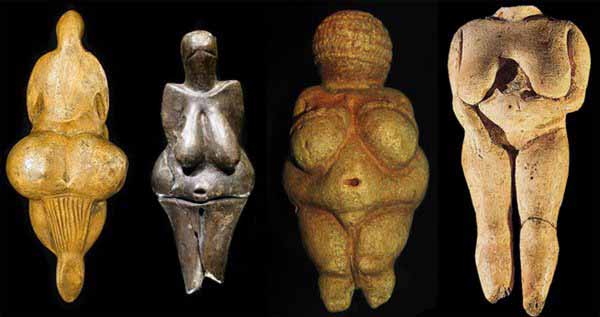
Venus Figurines
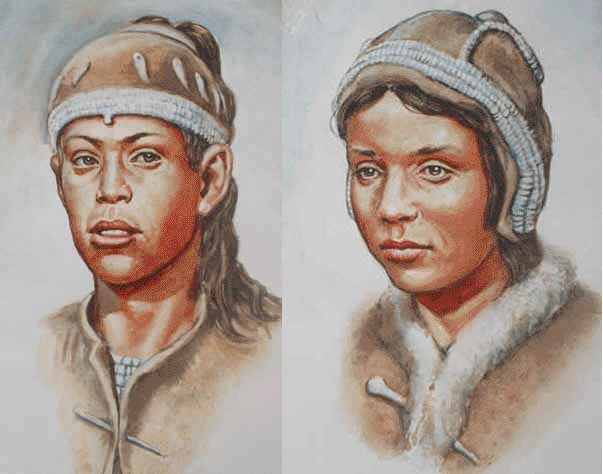
Northern Gravettian children |
27,500 y,a.: _ Haplogroup I2 - M438 developed in Anatolia or in the Ukraine refugium.
26,500 y.a.: The Oranui (VEI 8) eruption of New Zealand's Taupo Volcano
It was the world's largest known eruption in the past 70,000 years since Mt. Toba.(except perhaps Tierra Blanco Joven, about 500 A.D.). It may have been a significant contributing cause of the following Late Glacial Maximum (LGM).24,500 y.a.: Maximum ice coverage (LGM).
All northern European populations were driven south where they survived living in "refugia". There were three main refuge areas: Ukraine, Balkan and Iberian. Mean Sea Levels are believed to be 110 to 120 meters (361 to 394 ft) lower than present.
Life in the refugia
20,000 y.a.: End of the LGM. The very short Meiendorf Interstadial warm period began.
The populations cooped up in the refugia broke out into open territory. Unfortunately, it was a climate trap. Only a thousand years later - about forty generations - the situation became very severe with the beginning of the Oldest Dryas ice age, the coldest and most lethal of all.17,900 y.a.: Haplogroup I2a1, called 'P37', originated from L460 in or near Ukraine.
----------------------- Page 13 ----------------------
P37 and the Oldest Dryas
19,000 y.a.: Oldest Dryas ice age began producing a very severe cold climate
The Oldest Dryas was the coldest and most lethal of the ice ages. A treeless "polar desert" 300 miles (500 km) wide developed across the entire width of Europe. It was similar to Arctic tundra. The onset of the cold was severe enough and fast enough that most of the northern populations perished before they were able to migrate south to the refugia. It was the second major extinction period in human history. Total population was reduced by more than 75%.18,300 y.a.: Vesuvius erupted at VEI 6 magnitude making a very bad situation worse.
18,200 y.a.: Haplogroup M-423 , emerged from P37 in the Ukraine Refugium.
18,000 y.a.: The few survivors all retreat to the various refugia
The extreme climate lasted for almost 4,000 years. In the refugia, once again the Malthusian catastrophe played out. FTDNA suggests the Oldest Dryas was a major extinction period. The Haplogroup I population was reduced to just eight haplotypes. This, of course, led to major 'founder effects' .18,000 y.a.: One of the founder effects was the development of the genes for pale skin
It is the mutation of two genes - SLC24A5 and SLC45A2 - that leads to depigmentation. (These genes are different from the genes that cause Albinism: OCA1, OCA2, and OCA3). Pale skin originated in a subset of the population in the refuge. The small groups that went north out of the refuge at the end of the Oldest Dryas contained a large percentage of this pale skin subset. The trait spread slowly throughout the population.17,900 y.a.: Haplogroup I2a1, called 'P37', originated from L460 in or near Ukraine.
Founded just after the rather short (1,000 year) Meiendorf Interstadial warm period had ended. The timing was unfortunate since the next climate change was a quick change to a very severe cold period - the Oldest Dryas. Those who had settled westward all the way to France were able to retreat to Iberia, the Franco-Cantabrian area, and the Dalmatian coast to find refuge. The Ukraine refuge and the Danube valley remained open for passage, so some P37 were able to migrate west up the valley. Those who went north - died.
(SNP P37.2 defines this group)
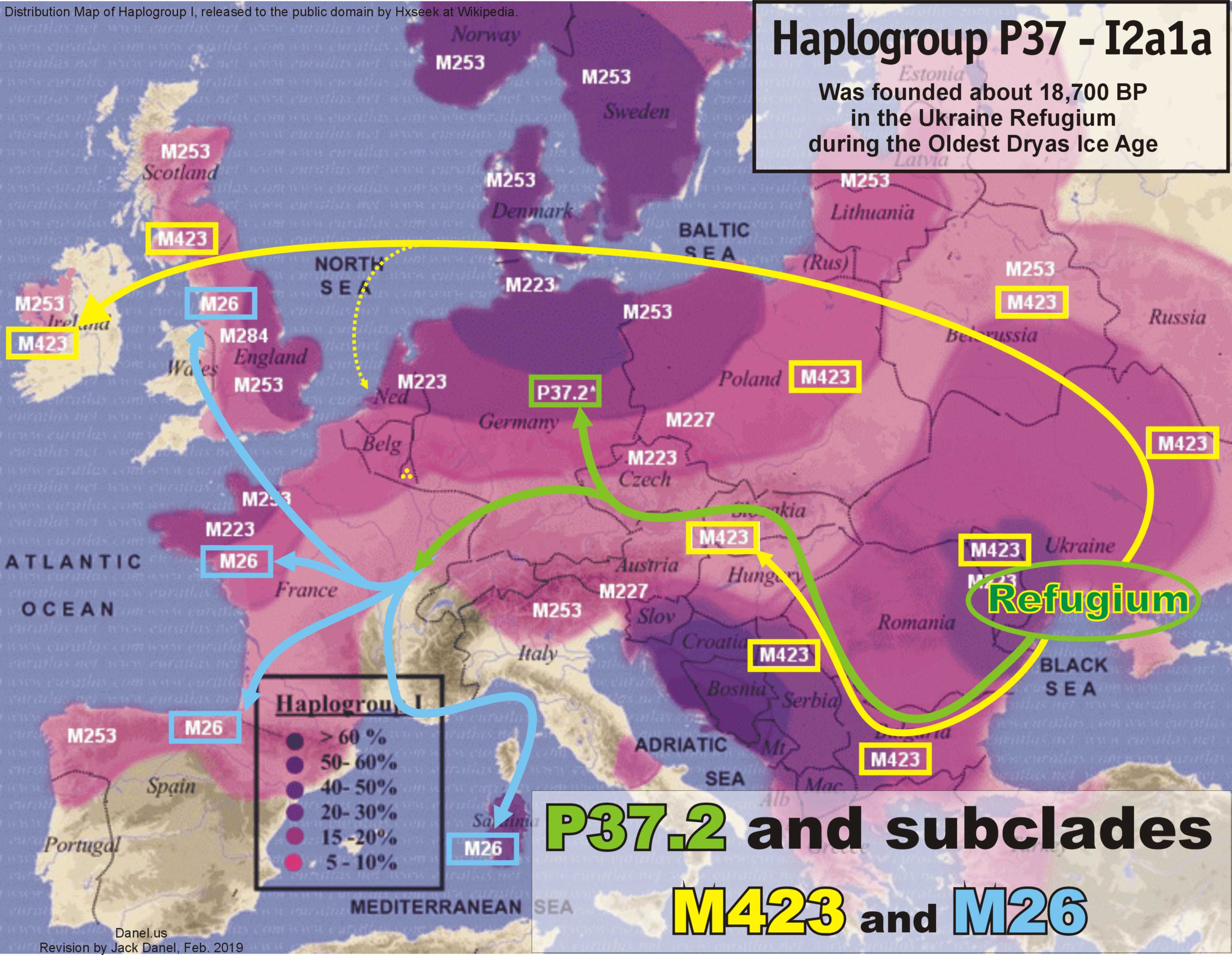
|
I2-M438 and its several descendant subclades L460, M223, M26, P37, and M423 survived the extreme climate of the Oldest Dryas in the Ukraine refugium, in the Balkan refugium, in protected valleys along the length of the Danube and in the Ibero-Franco-Cantabrian refugium. |
17,800 y.a.: 'Alpine' branched off P37-west in the Danube basin. West Isles, and "France" were some of the other splinter branches.
16,000 y.a.: Vesuvius erupted at VEI 5 magnitude
15,500 y.a.: 'Western' emerged from P37-west in the upper end of the Rhine or Danube.
14,670 y.a.: End of the Oldest Dryas ice age
----------------------- Page 14 ----------------------
M423
Most of modern Haplogroup M423 descendants are in the Balkans. Another 10% is spread out over eastern Europe. These groups are shown as the yellow tracks in the diagram. The tiny remainder are the Disles and L161 Isles haplogroups in Britain, shown as the green line.
17,900 y.a.__ Haplogroup M-423 , emerged from P37 in the Ukraine Refugium.
The founding was during the last millenium of the Oldest Dryas ice age, so it must have happened in a refugium. About 90% of modern Haplogroup M423 is in the Balkans. The other 10% is spread out over eastern Europe, with traces in western Europe and the Isles. (These groups are shown with yellow boxes and arrows in the diagram below). There is some disagreement as to whether it was the Balkan refugium or the Ukraine refugium. It could have been either one, but the complexities of getting the P37 up the Danube to found M26 in western France and then get M423 back down the Danube to found the Dinaric and Y3104 is a very complicated scenario. The simple scenario is that P37 was spread out over both the upper Danube and the Ukraine refugium at the same time.
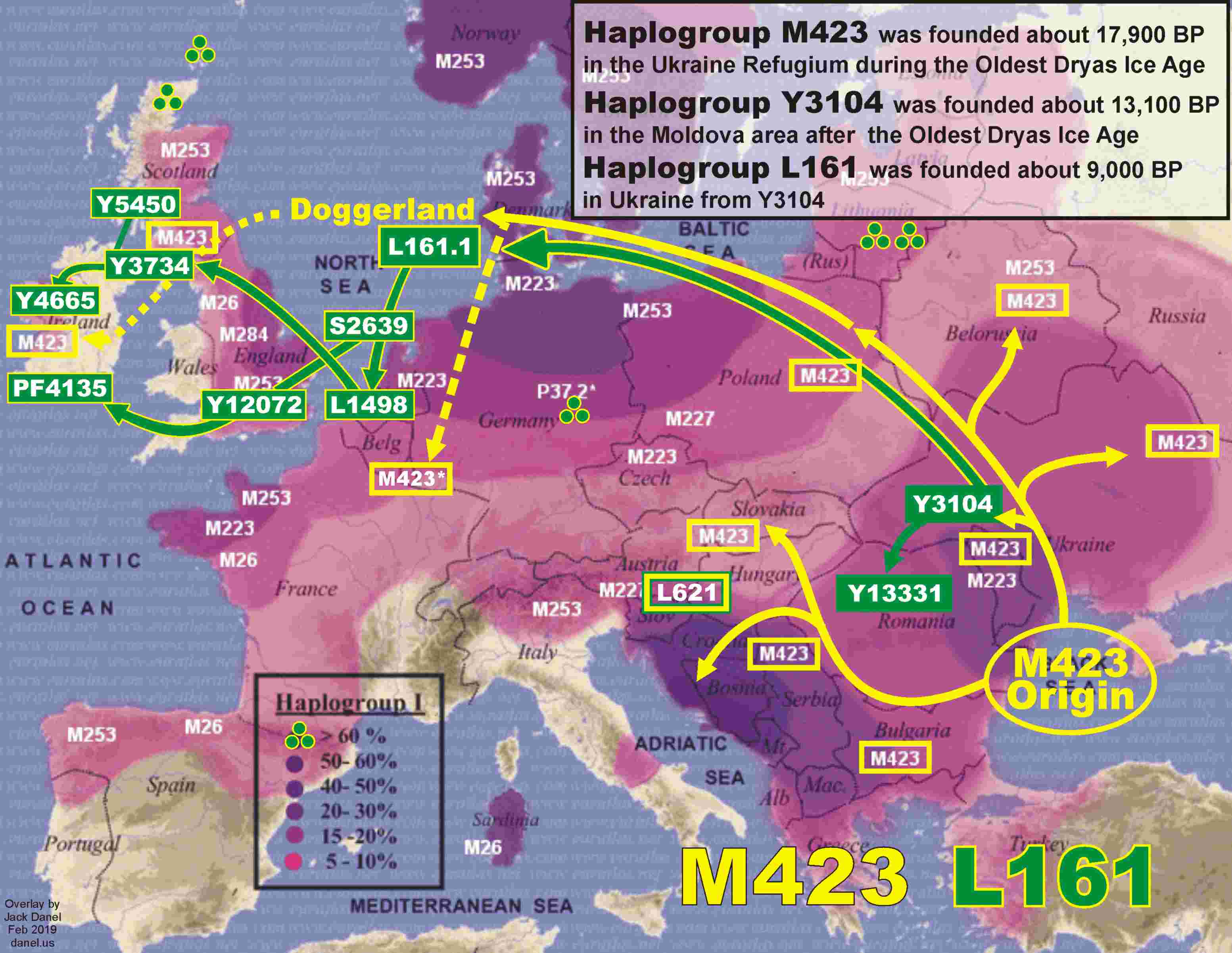
Distribution of M423, Haplogroup I2a1a |
14,670 y.a.: End of the Oldest Dryas ice age; the Bølling-Allerød interstadial, began.
The warm, moist period, the Bølling-Allerød, only lasted 1,750 years. Of the two periods, Bølling and Allerød, the Bølling is the warmer and came on more suddenly. Although the duration was quite short, the impact was immense: sea level rose about 35 m (!) due to glacial melt and also to the drainage of Lake Bonneville. Ice uncovered large parts of north Europe and temperate forests covered Europe from 29 deg. to 41 deg. north latitude. During this time, late Pleistocene animals quickly spread northward from refugia: reindeer, horse, saiga, antelope, bison, woolly mammoth, wooly rhinoceros, red deer, and smaller animals, such as fox, wolf, hare and squirrel. They were immediately followed by hunting groups that, over the next thousand years, developed the 'Hamburg' reindeer hunting culture. Today it is commonly accepted that the Hamburgian, featured by "Shouldered Point" lithics, is a techno-complex rooted in the Magdalenian. The Magdalenian was brought north by people migrating north from the Franco-Iberian refugium. The people migrating north from the Ukraine refugium, our ancestors the M423, were still using the Gravettian or Epi-gravettian culture. There was cultural intermixing involved in the development of the Hamburg culture, as would be expected.14,500 y.a.: M26-Sardinian branched off from P37-west in eastern France
14,000 y.a.: Post-glacial re-population of Southern England began
13,800 y.a.: Y3104 branched off from M423
13,500 y.a.: Hamburg / Ahrensburg culture was established in the north German plains.
The 'Hamburg (a nomadic reindeer hunting culture) evolved into the similar Ahrensburg culture and stone tool technology. The earliest archaeological find of bow and arrow artifacts is in the Ahrensburg. Ahrensburg culture is normally associated with the Younger Dryas glacialization and the Pre-boreal period.13,350 y.a.: the relatively mild Older Dryas cold period lasted a brief time.
Donsmaps has an excellent writeup on these ice age hunters.
Glacial Lake Candona drained to the North Atlantic. This surge of meltwater to the North Atlantic 13,350 years ago is believed to have triggered the reduction in thermohaline circulation and the short-lived Northern Hemisphere Intra-Allerψd cold period, e.g. the Older Dryas.13,000 y.a.: L621-Dinaric branched off P37-east, perhaps near the Danube delta.
12,900 y.a.: _The Younger Dryas little ice age began abruptly.
There is evidence that it was perhaps caused by a collision with a comet, and compounded by one of the drainages of Lake Agassiz and by the eruptions of the Campi Flegrei supervolcano and the Lacher See VEI 6 eruption . The sharp cold lasted 1,300 years, but was not as severe as the Oldest Dryas. Some small groups were able to 'winter through' and survive in small villages as far north as Hamburg Germany. Most, though, were driven back into or near the refugia. I show Y3104 as being just north of the Ukraine refugium during the Younger Dryas after having been further north on the plains. England was depopulated during the Younger Dryas.12,000 y.a.: Campi Flegrei erupted at VEI 6(?) magnitude
11,660 y.a.: End of the Younger Dryas marks the
11,660 y.a.: End of the Pleistocene and the
11,660 y.a.: End of the Paleolithic.
11,660 y.a.: Roughly correlated with Bond Event 8
11,660 y.a.: Beginning of the Boreal climate period
From the end of the Younger Dryas, the glaciers have been in retreat. It was the beginning of the Boreal climate period with a climate similar to today's.11,660 y.a.: Beginning of the Mesolithic
The difference between the paleolithic and the mesolithic is based on their technology and lifestyle. Paleolithic peoples used crude stone tools made by chipping and lived nomadically in crude shelters and caves. In the mesolithic, better stone tools were shaped and polished by grinding, pottery was coming into use, and some permanent housing structures were built.
----------------------- Page 15 ----------------------
Haplogroup L-161
11,660 y.a.: Beginning of the Mesolithic
11,600 y.a.: As glaciers retreated, M423 migrated north from the Ukraine Refugium.
The Don, the Dniester, the Dnieper, the Vistula, the Volga, and the Prut - all these rivers would lead northward allowing these migrants to reach the shores of a huge freshwater lake called Lake Ancylus (the Baltic Sea in a freshwater phase).11,000 y.a.: The Maglemosian culture was established around the shores of Lake Ancylus
and westward across Doggerland. The Maglemosian lasted 3,000 years until the catastrophic "8.2 kiloyear event".11,000 y.a.: Vesuvius erupted at VEI 4 magnitude
11,000 y.a.: The hair color gene MC1R causing blond hair developed in northern Europe.
There are several other gene variations that cause blond and other colors of hair that occur randomly across the entire world.10,000 y.a.: A genetic mutation caused blue eyes.
This was a unique event affecting the OCA2 gene occured in one woman, resulting in blue eyes. This unique gene is transmitted mitochondrially. All blue-eyed people have this woman as an ancestor.9,000 y.a.: Haplogroup L-161 currently known as I2a1a2a branched off from M423 or Y3104.
The founding location was somewhere between Lake Pontus (the Black Sea in a freshwater phase) and Doggerland. The founding was in the Boreal normal climate phase, so the geographic possibilities for the location are numerous. There were five major river deltas in that area, so the environment for hunter-gatherers was ideal.L-161 moved westward along the shore of Lake Ancylus and into Doggerland, a huge marshland three times the size of Ireland where the mesolithic lifestyle was relatively easy. They participated in developing and using the emerging mesolithic Maglemosian culture and stone tool technology.
(SNP L-161.1 defines this group)
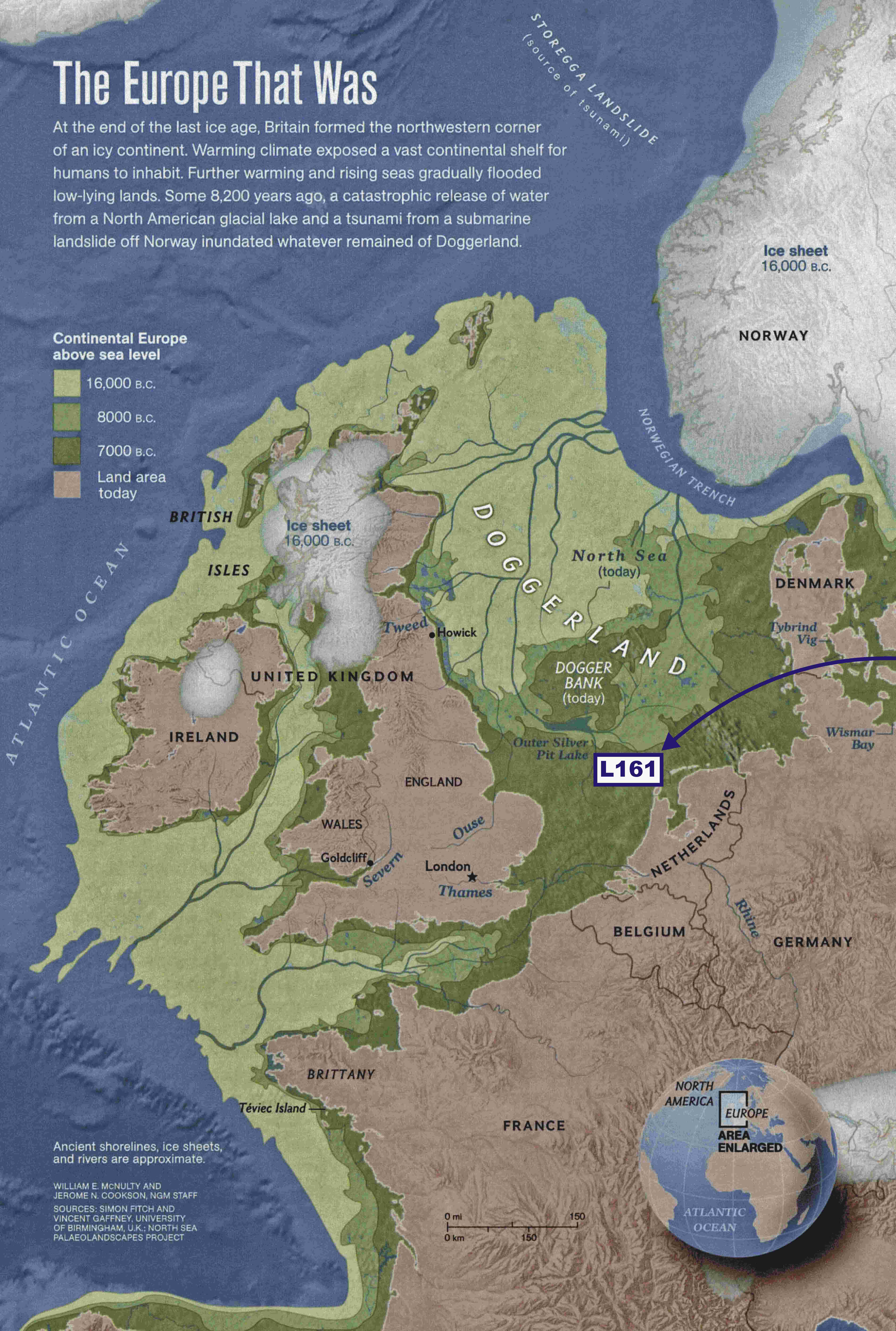
Doggerland, a mesolithic paradise |
Several subgroups of Haplogroup I2a coming north from the Iberian refugium would have been among the pioneers to cross the landbridge as the ice retreated and the 'forebulge' moved northward. People were not the only pioneers across the landbridge. Plants and animals also used the landbridge.
----------------------- Page 16 ----------------------
L-161 and the Doggerland Disaster
Haplogroup L161 was living an easy life in Doggerland, Resources were abundant and the mesolithic methods provided a good living. It was almost paradise. Then, with no warning at all,
it was all gone and most of them were dead. The 8.2 kiloyear event was not just one event, but are nine separate catastrophic events forming a 600 year long series of disasters.
- the drainage of Lake Agassiz, which raised sea level 3 meters and triggered
- three major Storegga tsunamis
- a change in ocean currents caused by the drainage.
- a VEI 6 eruption of Mt. Vesuvius.
- a 400 year long cold period caused by deviated ocean currents and the Vesuvius eruption
- collapse of the food chains, both land-based and freshwater
- mass starvation and
near (98%) extinction
The dreadful sequence began with the drainage of Lake Agassiz which caused sea level to rise 2 to 4 meters (7 to 13 feet) over about thirty days. The rising sea flowed back into Lake Ancylus, changing it from fresh water into the saline Littorina (Baltic) Sea. The climate abruptly turned cold and stayed cold for 400 years. The entire food chain collapsed.8,200 y.a.: Storegga landslide tsunamis and Flooding of Doggerland.
There were three main tsunamis over a 200 year span. The shoreline waves were estimated to be over 100' high (32 m.). In Scotland, traces of the tsunami have been recorded, with deposited sediment being discovered in Montrose Basin, the Firth of Forth, 50 miles (80 km) inland. These were much larger in scale, scope and fatalities to the devastating 2004 Indian Ocean earthquake and tsunami. Many northern Haplogroups show evidence of a major 'population bottleneck' event at just this time. Haplogroup L161 shows evidence of a very severe 'population bottleneck' event at exactly this time - with a 98% extinction rate. The '8.2 ky events' are the 'Mt. Toba' of northern Europe, so it must be a major factor in that extinction.
Similar events happened simultaneously around the world. Lake Pontus was flooded to change it from a fresh water lake to the saline Black Sea. The Ur-Shatt valley was flooded with salt water to become the Persian Gulf. The freshwater food chain collapsed leading to famine among those shore dwellers that survived the flood. (Some suggest these events are the inspiration for Noah's flood stories worldwide).
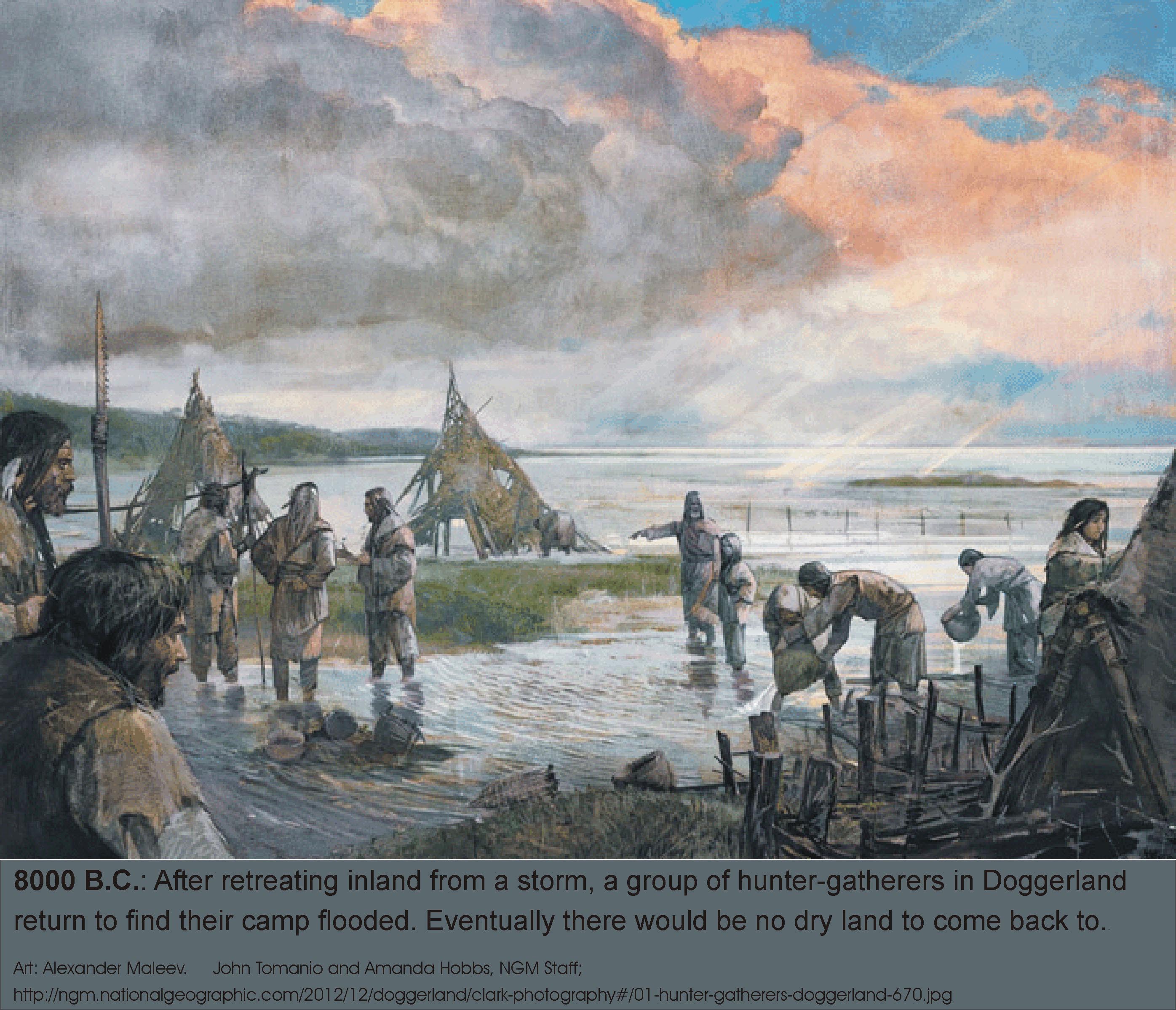
Disaster in Doggerland |
The simultaneous timing of the population bottleneck and the 8.2 kiloyear disasters is very strong evidence for concluding that L161 was in Doggerland - no other explanation is available as to why that extremely severe bottleneck happened exactly then. Without such an explanation, we can rule out the various other suggested migrations of L161 to Britain: with the Celts, the Anglo-Saxons, the Halstadt people, or with the Cord-ware people, etc. Furthermore, there are essentially no traces of L161 in the original locations of these other people - Celts, Saxons, etc. The idea of bringing 100% of the Isles AB-S2639 population along from these areas, leaving no traces behind, is very difficult to accept.)
8,200 y.a.: The few survivors of L-161 were forced south
There were remaining dry parts of Doggerland still formed a landbridge near what are now the Dogger Banks in the North Sea. Southeast of there, the Rhine river came out of Europe and joined the Thames as they both flowed far south to the Atlantic ocean.8,000 y.a.: Vesuvius erupted at VEI 6 magnitude
----------------------- Page 17 ----------------------
Recovery
Haplogroup L161 had been living an easy life in Doggerland until the "8.2 kiloyear event" almost exterminated them. The few survivors washed up on the shorelines to recover: Isles A and some Isles B on the west, the rest of Isles B on the eastern shore of what are now the North Sea. A very few L-161, Y13331(?), were left behind along the route of migration.
The recovery was helped by the arrival of the especially warm climate of the 'Atlantic' period. It was impeded by the cultural isolation caused by the open water barrier of the English Channel.
8,000 y.a.: Kongemose culture was developing in Doggerland.
The survivors of the 8.2 kiloyear event took that culture with them. With the shoreline resources devastated, they concentrated more on hunting red deer, roe deer and wild boar with stone axes and spears. The microlith tools that were made on the continent are very reminiscent of those made along the English shoreline - hypothetically - by the L-161 survivors. English technology did not advance until the neolithic revolution about 6,500 y.a.7,500 y.a.: Pale skin became ubiquitous in northern Europe
7,500 y.a.: The Atlantic climate period began, warmer than the present.(7,500-5,000 y.a.)
7,000 y.a.: Haplogroup S2639 formed and spread east-west along the shoreline.
S2639 quickly developed two main subgroups Isles A Y12072 and Isles B L1498. The continuing rise of sea level caused a continued migration that split the people of S2639.6,800 y.a.: Isles B - L1498 emerged and quickly generated three new branches.
These groups, Y12993, A10029 and Y3749 were located along the south shore of the North Sea. This abrupt proliferation is indicative of a benevolent environment. The south shore during the Atlantic climate period would have been just such a place.6,800 y.a.: Isles A - Y12072 emerged from S2639.
Isles A, in stark contrast, did not produce a single surviving branch for 3,700 years. This is indicative of a very hostile environment keeping the whole population on the edge of extinction the entire time. It is not clear why East Anglia would have been so hostile. Starting from a very small population base, perhaps just one man or a small family, operating in a competitive tribal situation might have been the cause.6,500 y.a.: The English Channel opened, becoming an open water barrier and splitting Y3749.
Sea level continued to rise which changed the geography. The English Channel, previously not much more than a swamp - passable with some difficulty, but passable - became a serious open water obstacle. Britain became isolated. Haplogroup Y3749 was split by the new obstacle. Those on the east side became S2742 and those on the west became Y3722 around 6,400 ybp.
Previous estimates cover a span of about 3,000 years, but this genetic split seems to nail it down to a time after the founding of Y3749 and before the founding of the subclades S2742 on the east side and Y3722 on the west side. These foundings are currently calculated to be 6,800-6,400 ybp. The cause of the opening is more than just sea level rising. That was a factor, but much more important was ""forebulge collapse"". The 'forebulge' caused Doggerland to rise. One estimate is that the centre of the North Sea rose by about 170 m (558 ft) during the Ice Age because of forebulging.[2] As the ice melted, the forebulge collapsed and the English Channel opened. This forebulge effect is also the mechanism that provided, and then removed, the landbridge from the Franco-Cantabrian refugium to Ireland.
In an astonishingly short period of about 200 years all the mesolithic groups adopted an entirely new way of life involving keeping domestic animals, cutting hay to feed the animals, ability to milk the animals, pottery to hold the milk, the ability to make cheese, and many other things known as the "secondary products revolution". By natural selection, Lactose tolerance begins to evolve among dairy herders. The whole cluster of advances is lumped together as the "neolithic revolution. The blazing fast speed of the transition was perhaps aided by exogamous patrilocal marriage practices in which the bride took her dowry of a calf and the knowledge of dairy practices and pottery making to her new husband's home. The neolithic revolution did not happen on Albion because the newly opened English Channel blocked the arrival of new ideas until better boats were developed. Some farmers had made it across, but adoption of farming was slow. England remained mostly mesolithic for the next 2,000 years until the Bell Beaker folk arrived.6,500 y.a.: Alghaffar branched off a remnant of L-161, perhaps back in the Ukraine refugium
----------------------- Page 18 ----------------------
The Isles Groups in Albion
6,500 y.a.: The Mesolithic / Neolithic transition happened very slowly in Albion.
The major obstacle presented by the newly opened English Channel seems to have sloweded the new ideas from crossing and quickly making a successful foothold as they had done elsewhere. The Kongemose-like mesolithic culture stayed in use alongside the neolithic improvements in farming for another two thousand years.6,000 y.a.: Farming and stone circles introduced into England
The farmers were genetically similar to Iberians. It is thought they were haplogroup I who migrated north from the Iberian refugium. The stone circle 'religion', if it was one, remains a mystery. Stone circle construction seems to have started in northern England coastal areas and progressed southward along the west coast.5,370 y.a.: TMRCA of continental group of Isles B
TMRCA = Time to Most Recent Common Ancestor5,000 y.a.: End of the Atlantic very warm climate period, begin Subboreal

Stonehenge |
5,000 y.a.: Construction began at Stonehenge
The Windmill Hill culture, perhaps an "East Anglian tribe", began construction of the immense Stonehenge complex and the other nearby sites: Woodhenge, Durrington Walls henge, and the connecting pathways, etc.
The timing of the ending of the Atlantic warm period with the simultaneous beginning of construction of Stonehenge with is striking. Surely that can not be coincidental. The cooling would have led to many adjustments to their lifestyle. There may have been crop failures, game reductions, and obvious weather changes that could have sparked a resurgence of religious fervor in an attempt to appease the gods and stop the changes. The immense amount of labor that went into Stonehenge must have had some serious motivation far beyond the ordinary course of events.
Construction continued for just over a thousand years. It ended coincident with the arrival of the Bell Beaker folk who caused a 97% replacement of the Y haplogroups building the site and who also brought a complete change of culture and religion.
4,740 y.a.: TMRCA of the Isles B British group
4,700 y.a.: The start of the Bell Beaker invasion and the very short Chalcolithic.
See pg 19. The Bell Beaker folk came with copper technology, superior weapons, cavalry, and wagons. The mesolithis indigenous folk were no match for them. the result was a 95%+ replacement of the Y haplogroups. This may have been a displacement or it may have been a severe "ethnic cleansing".4,500 y.a.: Bronze Age began in Britain, brought by the Bell Beaker folk
Copper mining in Cork and tin mining in Cornwall4,500 y.a.: Lactose tolerance dominant throughout Europe
4,500 y.a.: Domestic horses in Britain brought by the Bell Beaker folk.
4,300 y.a.: Eruption of Hekla 4 Volcano (VEI 4) in Iceland. "Ireland was thirty years waste".
4,200 y.a.: Bond Event 3, glaciers increase worldwide.
4,050 y.a.: Seahenge constructed in Norfolk, the last gasp of the old religion?
3,800 y.a.: Vesuvius erupted at VEI 5 magnitude
3,645 y.a. __1627 BC events [29] Volcanic eruptions of Mt. Thera, Vesuvius, and Hekla 3
A series of immense volcanic eruptions- Mt. Thera VEI 7(Santorini), the 'Avelino' VEI 6 eruption of Mt. Vesuvius, Hekla 3 VEI 5, and others - from Iceland to Greece produced catastrophic environmental problems worldwide known as the '1627 BC events'.3,200 y.a.: TMRCA of Isles CD - Y3734, founded in East Anglia
They caused eight decades of severe climate recognized in Chinese records, Irish bogs, and dendrochronology, 1630-1544 bc. That caused the simultaneous collapse of many ancient civilizations, known as the "Bronze Age Collapse". Geologists think Mt. Thera may be the strongest explosion ever witnessed by modern humans.
3,350 y.a.: King Tut ruled in Egypt
3,200 y.a.: Isles C-Y5450 branched off from Y3722(Y3734) in the Dal Riata area.
3,200 y.a.: Isles D-Y4660 branched off from Y3722(Y3734) in Ireland, perhaps near Rathcroghan
3,000 y.a.: Eruption of Hekla 3 (VEI 5) in Iceland
There was an 18 yr. temperature drop in the northern hemisphere.2,900 y.a.: PF4135 Founded in Cork Ireland
2,800 y.a.: The Iron Age began in Britain
2,500 y.a.: The Subatlantic Climate period began
2,200 y.a.: TMRCA of Isles C - Y5450
----------------------- Page 19 ----------------------
----------------------- Page 20 ----------------------
500 Years of Catastrophe
2,000 y.a.: The beginning of a 500 year long series of catastrophies.
All Europe suffered. The population dropped by 25% from 36 million in 200 AD to 27 million in 500 AD. It took another 500 years for the population to climb back to what it was in 200 AD. It seems clear that the subgroups of L161 were not spared. The TMRCA of Isles C and D indicate some fairly serious bottlenecking. Isles A was very close to extinction.
2,000 y.a.: Small invasions by the Angles, Saxons, Jutes, and Danes began and continued for 500 years.1,450 y.a. __The Diaspora of Isles A - the subclades go their separate ways.
1,973 y.a.: The Roman invasion and conquest (43 AD) under the Emperor Claudius began a 350 year long series of rebellions and guerilla warfare.
1,937 y.a.: The VEI 5 eruption of Mt. Vesuvius (79 AD) caused crop failures as well as burying Pompeii.
1,850 y.a.: The Antonine Plague and Britain's Great Plague.
1,750 y.a.: The Plagues of Cyprian and Aurellian wreaked havoc for 20 years.
1,600 y.a.: The Roman withdrawal (410 AD) left a power vacuum that was soon filled by the invading Angles, Saxons, Jutes and Danes.
1,500 y.a.: TMRCA of Isles D - Y4660
1,500 y.a.: Main Anglo-Saxon invasion. - Cerdic the Saxon became King of WessexThe invasions were propeled by some frigid years of crop failure - a result perhaps of the TBJ volcanic eruption (next pagagraph). The slave trade flourished selling native Britons (including Isles B) to the European continent. This could account for most of those rare Isles B individuals found there. In 577 AD, Cerdic's great-grandson Ceawlin completed the Saxon conquest of England with his victory at the battle of Deorham (in the suburbs of Bristol). (If you are of British stock, Ceawlin is your approximately 40th great-grandfather.)1,500 y.a.: The enormous Tierra Blanco Joven - "TBJ" eruptionThe eruption of the Ilopango volcano in El Salvador had disasterous effects killing millions worldwide. New findings would make it the second-largest volcanic eruption in the last 260,000 years (After Mt. Toba, VEI 8 - 73 kya, and tied for second/third place with the Oranui eruption, VEI 8 - 26.5 kya, and the Whakamaru eruption, VEI 8 - 254 kya, of New Zealand's Taupo volcanic zone,.1,500 y.a.: Bond Event 1.
1,500 y.a.: AD 536 Events" caused two decades of famine.
1,500 y.a.: The Plague of Justinian killed at least 25 million Europeans
The 500 year long series of catastrophies from 2,000 to 1,500 years ago drove Isles A to the brink of extinction as is shown by the shockingly low TMRCA of 1450 years.
By 500 A.D. there may have been only one family of Isles A-PF4135 left alive. They were located in the area of Cork and Bantry Bay in southern Ireland. Then their luck abruptly changed about 1,450 years ago. Three new subclades were formed and they survived, something which had not happened in 1,500 years and another 4,000 years before the previous one. The three subclades were A13364, Y11772, and A11374. The most successful group was A13664 who made Cork their home and there they prospered, becoming the famous and powerful Driscolls. Y11772 developed two subgroups that migrated north, Y12075 and A11115. Y12075 successfully established a home in Scotland. A11115 went to the Isle of Man, Northern Ireland, and Scotland. All the A11374 seem to have migrated to America. (One individual of A11115 settled in Wiltshire, south of Bristol, England. His great-grandson emigrated from Bristol to Virginia in 1635 so that group is now, so far as we have evidence, extinct in the British Isles.)
----------------------- Page 21 ----------------------
The current situation
Haplogroup L-161 is a tiny group that comprises less than 1% of the European population. It is found predominately - more than 95% - in the British Isles. For that reason, the label "Isles" has become attached.
The branches of Haplogroup I that have led to the modern L161 subclades are:
M170—I
— ⤷—➤ M438—I2
——— ⤷—➤ P37—I2a1a
————— ⤷—➤ M423—I2a1a2
——————— [⤷—➤ Y3104 —I2a1a2 removed by ISOGG 2018, retained by Yfull ]
———————⤷—➤ L161—I2a1a2a
—————————⤷—➤ S2639—I2a1a2a1 —Isles AB
—————————————↓ ⤷—————➤ Y12072 I2a1a2a1b ➤ PF4135 - Isles A I2a1a2a1b1
————————————— ⤷———————➤ L1498 - Isles B I2a1a2a1a
——————————————— ⤷—➤ Y3734 - I2a1b1a1a1b3
—————————————————↓ ⤷—➤ Y5450 - Isles C - I2a1b1a1a1b3a
————————————————— ⤷———➤ Y4665 - Isles D - I2a1b1a1a1b3b
Isles A is concentrated around Cork and is present, but rare in Ireland, Isle of Man, and Scotland.
Isles B is now found all across the British isles and to a very minor degree on the continent.
Isles C is located mostly in the north of England, Scotland, Ulster and western Ireland.
Isles D is relatively strong in the northwestern parts of Ireland, especially around Rathcroghan.
The I Group as a whole has a very different current distribution. Most are in Europe sandwiched between Haplogroup R1a on the east and R1b on the west. It is not at all clear how that came to be. There are many diverging opinions.
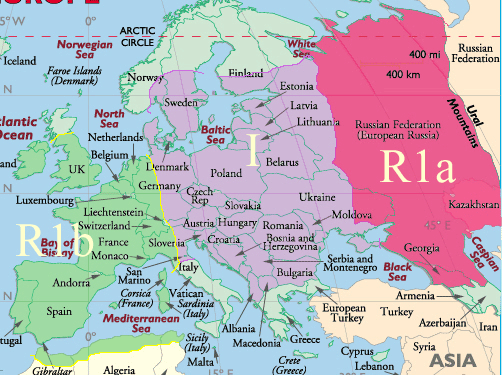
Current Main European Haplogroups |
----------------------- Page 22 ----------------------
Climate, Culture, and Volcanic Events
| Climate | from | to | Name | Y Haplogroup | Culture |
| cold | 2.6 | 2.4 | Pre-Tiglian complex | Homo habilis | Lomekwian |
| cold | 1.8 | 1.6 | Biber glaciation Eboronian | Homo erectus | Oldowan |
| ....VEI 8 | 1.5 | . | Karymshina Russia VEI 8 eruption | . | Acheulean |
| warm | 1.4 | 1.1 | Biber-Danube interglacial | . | . |
| cold | 1.1 | 866 | Danube glaciation | . | . |
| warm | 866 | 676 | Danube-Gunz interglacial | Homo antecessor | Acheulean |
| cold | 676 | 621 | Gunz glaciation | H heidelburgensis | Acheulean |
| warm | 600 | 540 | Gunz-Haslach interglacial | . | . |
| cold | 540 | 500 | Haslach glaciation | Proto neanderthals | Clactonian |
| warm | 500 | 478 | Haslach-Mindel=Cromerian interglacial | . | . |
| cold | 478 | 424 | Mindel Glaciation | Proto-neanderthals | . |
| warm | 424 | 347 | Holstein=Mindel-Riss Warmzeit | H rhodesiensis | Acheulean |
| cold | 347 | 230 | Riss Saale; split proto-neanderthals | A00, "Perry" | . |
| ....VEI 7 | 280 | .. | Haroharo Caldera VEI 7 | . | . |
| ....VEI 8 | 254 | .. | Whakamaru Caldera VEI 8 | . | . |
| cold | 230 | 133 | Saale = Riss | A0, "Omo" | . |
| ....VEI 7+? | 220 | .. | Puy de Sancy volcano in France VEI 7+? | A, Neanderthals | . |
| warm | 130 | 115 | Eemian Interglacial | A, Homo idaltu | . |
| warm, wet | 133 | 100 | Abbassia Pluvial in the Sahara | CT | . |
| cold | 115 | 50 | Weichselian ice age | CT - F | . |
| ....VEI 8 | 75 | .. | Mount Toba, largest eruption in 25 million yr. | CT | . |
| warm | 50 | 41.3 | Glinde and Moershoofd Interstadial | F - I | . |
| warm | 41.3 | 39.4 | Hengelo Interstadial | I, Cro-Magnons | Acheulean |
| cold | 39.4 | 34 | Huneborg Stadial | . | Mousterian |
| ....VEI 7 | 39 | .. | Campi Flegrei (1) caldera VEI 7 | . | Aurignacian |
| warm | 32 | 26.5 | Denekamp interstadial | I2 | Gravettian |
| ....VEI 8 | 26.5 | .. | Oranui VEI 8 | I2a | . |
| cold | 26.5 | 20 | LGM - Last Glacial Maximum | P37 | . |
| warm | 20 | 19 | Meiendorf Interstadial | . | Epi-Gravettian |
| cold | 19 | 14.7 | Oldest Dryas, (major extinction event) | M423 | . |
| ....VEI 6 | 18.3 | .. | Vesuvius (1) VEI 6 | M423 | . |
| ....VEI 5 | 16 | .. | Vesuvius (2) VEI 5 | . | Magdalenian |
| warm | 14.7 | 12.8 | Bolling-Allerod interstadial | Y3104 | Hamburg |
| cool | 13.7 | 13.5 | Older Dryas | . | . |
| ....VEI 6 | 12.9 | .. | Lacher See VEI 6 | . | . | cold | 12.8 | 11.7 | Younger Dryas | L161 | Ahrensburg |
| ....VEI 5? | 12 | .. | Campi Flegrei (2) VEI 5? | . | . |
| normal | 11.7 | 8.2 | Boreal climate | L161 | Maglemosian |
| ....VEI 4 | 11 | .. | Vesuvius (3) VEI 4 | . | . |
| cold | 8.2 | 7.8 | The 8.2 kiloyear events | S2639 | Kongemose |
| ....VEI 6 | 8 | .. | Vesuvius (4) VEI 6 | S2639 | . |
| warm | 7.5 | 5 | Atlantic climate | Y12072, L1498 | Mesolithic |
| dry, warm | 5 | 2.5 | Subboreal climate | . | Chalcolithic |
| ....VEI 4 | 4.3 | .. | Hekla 4 VEI 4 | . | Bronze Age |
| ....VEI 5 | 3.8 | .. | Vesuvius (5) VEI 5 | . | . |
| ....VEI 7 | 3.5 | .. | Mt. Thera (Santorini); "1623 bc events" | Y5450, Y4665 | . |
| ....VEI 5 | 3 | .. | Hekla 3; "Bronze Age Collapse" | PF4135 | . |
| normal | 2.5 | now | Subatlantic climate | . | Iron Age |
| ....VEI 5 | 1.9 | .. | Vesuvius (6) VEI 5; buried Pompeii | . | . |
| ....VEI 7+ | 1.5 | .. | Ilopango 'TBJ'; "Migration Period" in Europe | A13664, Y11772 | Y12075, A11115 |
----------------------- Page 23 ----------------------
Pre-human
| Ancestor | Emerged | Location, approximate | Name |
| "Ardi" | 5.5 mya | Afar, Ethiopia | Ardipithecus ramidus |
| "Lucy" | 3.2 mya | Afar, Ethiopia | Australopithecus afarensis |
| "Africanus" | 2.5 mya | South Africa | Australopithecus africanus |
| "Garhi" | 2.5 mya | Afar, Ethiopia | Australopithecus garhi |
Archaic humans (ice ages, warm periods)
| Ancestor | Emerged | Location, approximate | Name |
| Handy man | 2.5 | Olduvai Gorge, Tanzania | H. habilis |
| Upright man | 1.9 | Java, Kenya, China, Hungary | H. erectus |
| Heidelburg man | 700 kya | Germany, Spain, England | H. heidelburgensis |
| Rhodesian man | 600 kya | Zambia, Ethiopia, Tanzania | H. rhodesiensis = H. heidelburgensis |
Modern humans - AMH
| Haplogroup | Emerged * | Location, approximate | SNP | SNP Date |
| A00a Perry | bef. 270 | Western Cameroon | L1149 | 270 |
| A0-T | bef. 200 | Omo Kibish, Ethiopia | L1085 "Omo?" | 235.9 |
| A1 | 170 | Afar Ethiopia | P305 H. sapiens idaltu | 161.3 |
| A1b | 150 | East Africa | P114 H. s. sapiens | 133.4 |
| BT | 140 | Ethiopia | M91 | 130.7 |
| CT | 100 | East Africa | M168 | 88 |
| CF | 80 | Ur-Shatt | P143 | 68.5 |
| F | 70 | Ur-Shatt | M89 | 65.9 |
| GHIJK | 65 | Mesopotamia | F1329 | 48.8 |
| HIJK | 60 | Mesopotamia | F929 | 48.5 |
| IJK | 55 | Mesopotamia | L15 | 48.5 |
| IJ | 50 | Baghdad | M429 | 47.2 |
| I - Cro-Magnon | 45 | Kurdestan | M170 | 42.9 |
| I1 | 40 | Ukraine refugium | M253 | 27.5 |
| I2 | 40 | Anatolia | M438 | 27.5 |
| I2a1a** | 25 | Ukraine refugium | P37.2 | 18.7 |
| I2a1a2** | 20 | Ukraine refugium | M423 | 18.5 |
| I2a1a2** | 15.8 | Ukraine refugium | Y3104 (L161, L621) | 13.4 |
| L161.1 (I2a1a2a*) | 13.5 | Moldova | L161.1 (S2639, Y13338/1) | 10.6 |
| Isles AB (hg tree) | 10 | Doggerland | S2639 | 6.9 |
| Isles A | 7 | East Anglia ➤ Cork | Y12072 ➤ PF4135 ➤ Y12073(A2) ➤ Y19285 | 6.7 |
| Isles B | 7.2 | Rhine River Delta | L1498 ➤ Y3749 ➤ Y3722 ➤ Y3734 | 6.6 |
| Isles C | 6.5 | Dal Riata | Y5450➤ Y18393(C1) & Y5451(C2) | 3.4 |
| Isles D | 4.2 | Rathcroghan Ireland | Y4660(D) ➤ Y5280 | 3.2 |
* The 'emerged' date in this table is my estimate of the date the "Dunbar group" began its journey to separation. It is the date of the 'spark' that started events moving forward. That date must be, by definition, before any archaeologically or genetically calculated dates. The SNP dates are from www.yfull.com
** The alphanumeric designators for haplogroups are listed by the ISOGG and are subject to change every year, so they are useless over time. The actual SNP name does not change, so that is the preferred designator.
----------------------- Page 24 ----------------------
Timeline
(y.a. = years ago, ice ages)
195,000 y.a.: Humans occupy the Omo site in Ethiopia [54]
185,000 y.a.: Humans occupy the Misliya site in Israel
110,000 y.a.: The "Last Glacial Period" begins and lasts until about 10,000 y.a. with warmer interludes [34]
75,000 y.a.: Mount Toba VEI 8 eruption nearly causes extinction of Homo Sapiens [49]
70,000 y.a.: The successful Out-of-Africa migrations begin
65,900 y.a.: Haplogroup F founded - ancestor of 90% of all non-African men
50,000 y.a.: Cro-Magnons meet Neanderthals in the Caucasus
45,000 y.a.: Cro-Magnons learn Mousterian technology from the Neanderthals
42,900 y.a.: M170 - Haplogroup I founded southeast of the Black Sea [Map of Human expansion]
43,000 y.a.: Cro Magnons occupied Kent's Cavern in Devonshire England
32,000 y.a.: Weichsellian interstadial warm period begins. Humans spread farther into the north and west.
30,000 y.a.: Gravettian culture (30,000 - 20,000 BC) spread from Ukraine to Spain perhaps by M170 - Hg I,
28,000 y.a.: M253 - I1 founded probably in the Ukraine Refugium
27,500 y.a.: M438 - I2 founded probably in the Ukraine Refugium
26,500 y.a.: Oruanui VEI 8 eruption [51] Largest eruption since Mt. Toba. Cause of LGM?
26,000 y.a.: Maximum ice coverage (LGM). Population living in refugia
25,000 y.a.: Neanderthals extinct [52]
21,800 y.a.: L460 - I2a(M223) founded probably in the Ukraine Refugium
20,000 y.a.: End of LGM. Post-Weichsellian warm period begins, allowing populations to occupy parts of Europe
19,000 y.a.: Oldest Dryas ice age [40] begins, severe cold producing a treeless Europe similar to Arctic tundra
18,000 y.a.: FTDNa suggests major extinction period reducing haplogroup I population to just eight haplotypes
18,000 y.a.: Surviving populations retreat to the various refugia
17,900 y.a.: P37 - I2a1 founded, in or near the Ukraine refugium, spread quickly westward (up Danube?).
17,800 y.a.: M423 - I2a1a branched off P37 - east in the Ukraine Refugium
17,800 y.a.: M26 - Sardinian branches off P37 - west in southern France
14,670 y.a.: End of Oldest Dryas ice age; the Bolling-Allerod interstadial, a warm, moist period begins abruptly [35]
14,000 y.a.: Post-glacial repopulation of Southern England begins
12,800 y.a.: The Younger Dryas little ice age begins lasting 1,300 years
11,660 y.a.: End of the Younger Dryas
11,660 y.a.: End of paleolithic and beginning of mesolithic. [48] Beginning of Boreal warm period.
10,600 y.a.: L-161 branches off from M423 somewhere in northern or eastern Europe near the Black Sea
9,000 y.a.: L621 - Dinaric branches off P37 - east, perhaps near or north of the Black Sea
9,000 y.a.: Post-glacial repopulation of Ireland begins in Cork [13]
8,200 y.a.: Storegga Slide tsunamis and Flooding of Doggerland [2][3][4]
7,500 y.a.: Atlantic climate period begins, warmer than the present.(7,500-5,000 y.a.)
6,700 y.a.: Isles B branches off from Isles AB, probably in Doggerland
6,700 y.a.: Isles A branches off from Isles AB, probably in East Anglia
6,500 y.a.: Mesolithic / Neolithic transition - The "secondary products revolution" [12]
6,500 y.a.: English Channel opened, splitting Isles groups: Isles B on the east and Isles A on the west
6,400 y.a.: Isles CD split from Isles B by the newly open English Channel
6,000 y.a.: Farming introduced into England
5,370 y.a.: TMRCA of continental group of Isles B
5,000 y.a.: Bell Beaker folk arrive in Netherlands bringing Chalcolithic culture.
5,000 y.a.: End of Atlantic very warm climate period
5,000 y.a.: Windmill Hill culture-East Anglian tribe begin constructing Stonehenge [6]
4,800 y.a.: Mt. Pleasant henge constructed in Dorset [5]
4,740 y.a.: TMRCA Isles B British group
4,700 y.a.: Bell Beaker invasion. 95% of indigenous Y haplotypes removed from England
4,500 y.a.: Bronze Age begins in Britain [32], copper mining in Cork [11] and tin mining in Cornwall
4,500 y.a.: The horse domesticated in Britain [31]
4,300 y.a.: Eruption of Hekla 4 Volcano in Iceland. "Ireland was thirty years waste".
4,050 y.a.: Seahenge constructed in Norfolk [7]
3,200 y.a.: Isles C branches off from Isles CD in Dal Riata
3,200 y.a.: Isles D branches off from Isles CD in Ireland near Rathcroghan
3,000 y.a.: Eruption of Hekla 3 in Iceland - 18 yr. temperature drop in the northern hemisphere, probable famines.
2,800 y.a.: Iron Age begins in Britain
2,730 y.a.: TMRCA of Isles C
2,520 y.a.: TMRCA of Isles D
1,850 y.a.: The great Antonine Plague [20][21]
1,750 y.a.: The Plagues of Cyprian and Aurelian - 20 years of plagues [24]
1,500 y.a.: TMRCA of Isles A
1,500 y.a.: Anglo-Saxon invasion, slave trade flourishes [10]
1,480 y.a.: "AD 536 Events" [16] Plague of Justinian [8] , TBJ [9] erupts. Two decades of famine.
1,450 y.a.: The near-extinction and diaspora of Isles A
----------------------- Page 25 ----------------------
Tools of the cultures
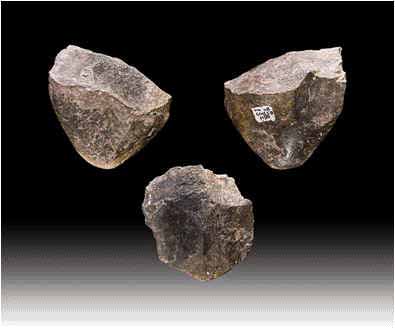
|
|
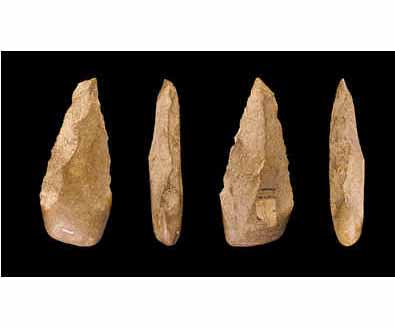
|
|
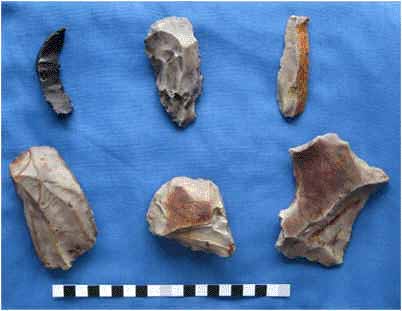
|
|
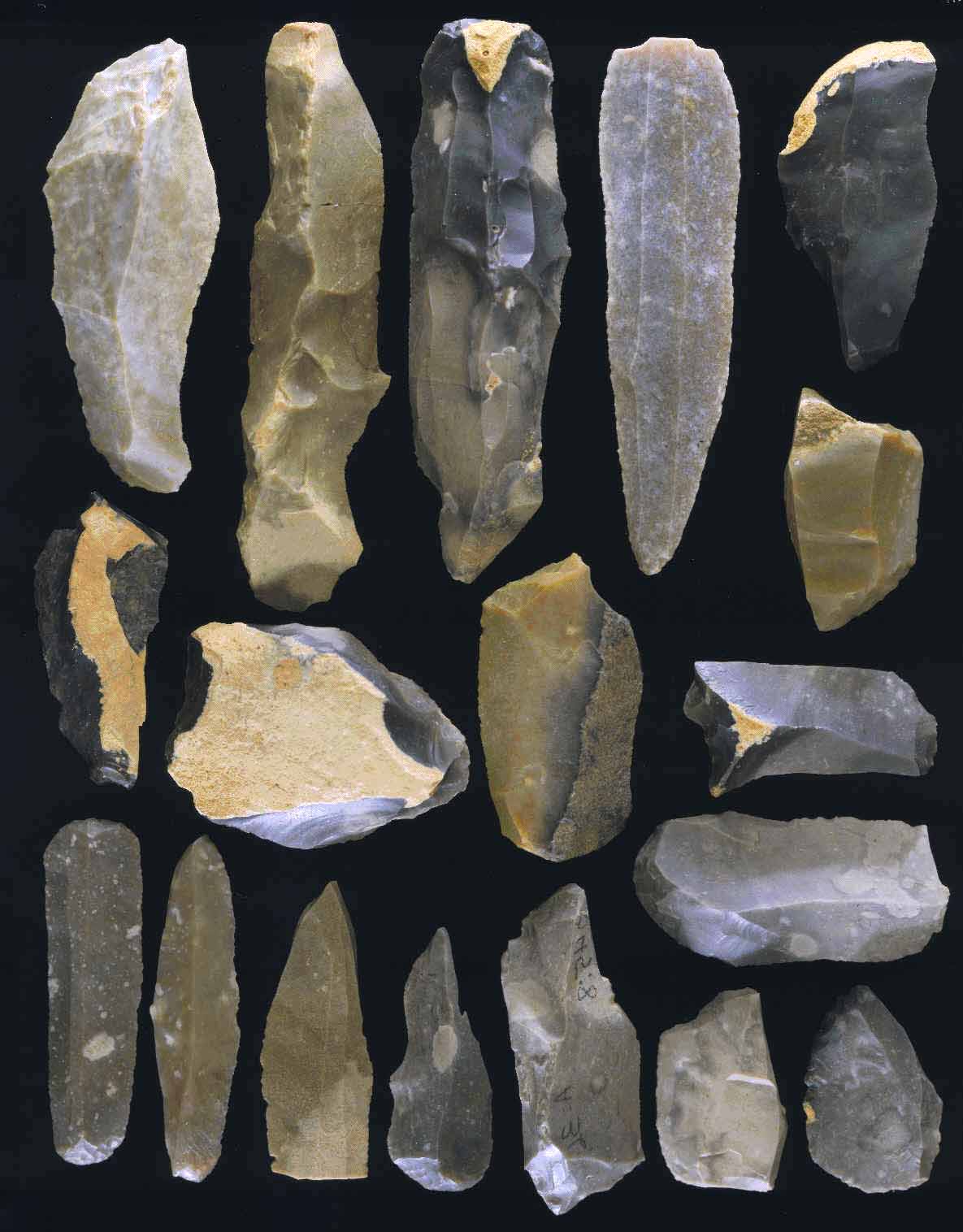
|
|
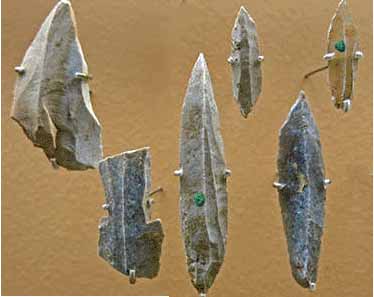
|
|
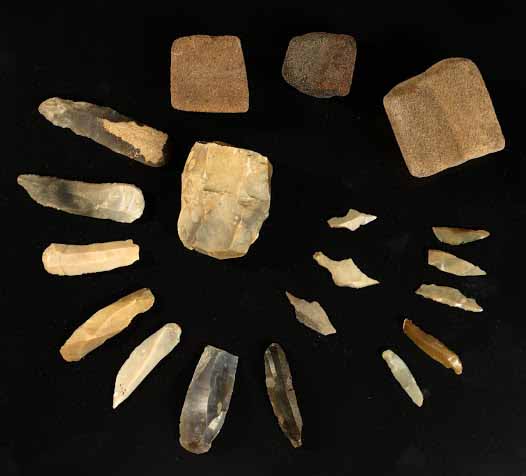
|
|
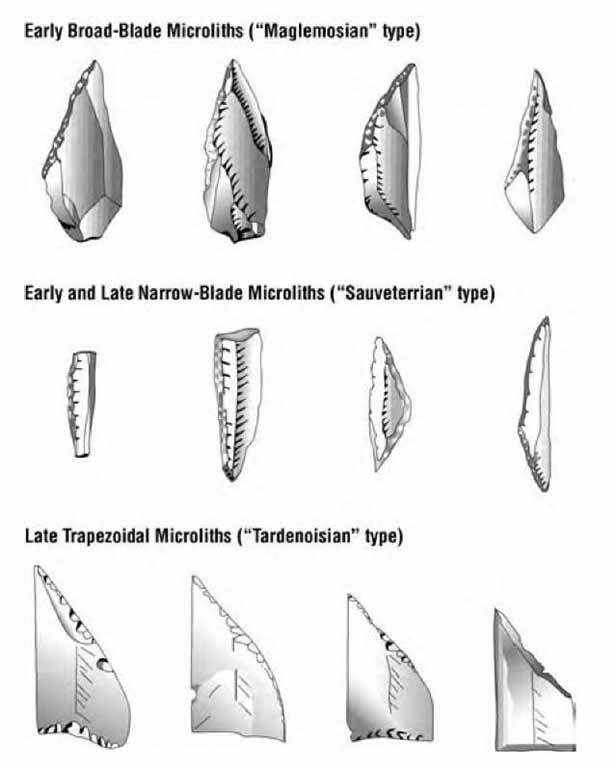
|
|
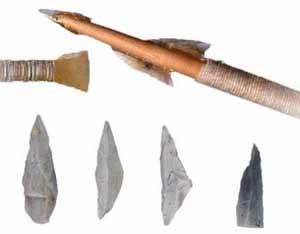
|
|
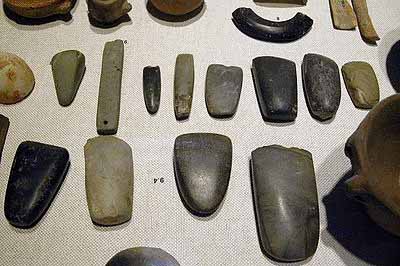
|
|
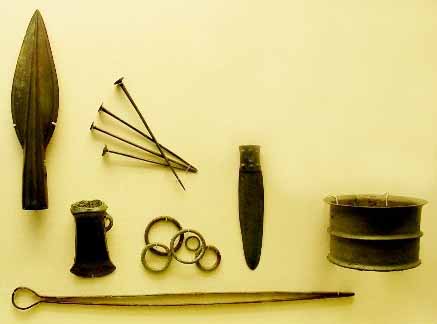
|
|
----------------------- Page 26 ----------------------
Misc. Notes
Disclaimers and cautions: The dates of genetic events are recalculated when new data comes in. By the time you read this, many of the dates will have changed, sometimes substantially. Furthermore the ISOGG names for the clades changes almost every year, so do not put too much reliance on the exact terminology or timing.
Branch Names: [22] The names of the branches of the genetic family tree are set and changed by various groups (ISOGG, FTDNA, YFULL, etc) using similar but not identical schemes every year. The scheme is cumbersome. For example the people in this haplogroup were (in 2012) I2a1b, but are now I2a1a2a. This causes great confusion. It is necessary to use the SNP for clarity.
SNP Names: Haplogroups can be clearly defined by a dna marker called an "SNP". The name of a SNP does not change, but they are not datable. Their timing is inferred from which haplogroups have them and which don't. Our group branched about 13,500 years ago, but our SNP L161.1 developed sometime between then and the next known branching about 6,000 years ago. Yfull.com now estimates it was 9,000 years ago.
TMRCA = Time to Most Recent Common Ancestor If L161 is so ancient, why is the TMRCA so short?
Bottleneck events shorten the TMRCA. [14] The founder was, for a while, the common ancestor and his chronology was the TMRCA. Then events happen that moved the TMRCA forward. The more severe the bottleneck, the more the TMRCA is moved toward the time of the bottleneck event.
FTDNA suggests that there was a massive extinction in our ancestors during the Oldest Dryas:
"Today, the genetic tree of humanity indicates there were only 8 males living at that time who were contributors to ALL of today's I-haplogroup population.
The 8 contributing males living 5000 years after the founding of I-haplogroup were certainly not the total population of living I-haplogroup males of that time. But this suggests how precarious that haplogroup was for a long period of its early existence." ---FTDNA
The eight patriarchs are these: P37, M423, L880, L624, M26; M223, M253, and L416.
Ice Ages: The ice age was not just one event. The ice came and went about ten times with warm periods in between. The warm periods and cold periods are shown on the 'Climate, etc.' page. When the ice was great, the people moved south and lived in survivable climates called "refugia." There were several of these refugia:
Franco-Iberian in Spain and southwest France (also called Franco-Cantabrian),
Balkan in Romania, Serbia, Hungary, and the upper Danube river valley,
Ukraine running from the Caspian Sea to the "Iron Gate" on the Danube.
L161 archaeology: There have been only ten remains found with identifiable L161 DNA:
7400 BP Lithuania Kretuonas
7310 BP Spain Els Trocs, L161+
7000 BP Lithuania Kretuonas
5500 BP Scotland L161.1
5500 BP Scotland L161.1
5230 BP Esperstedt L1498+ Isles B
5230 BP Esperstedt L1498 Isles B
5170 BP Orkney L161.1
5140 BP Orkney L161.1
4510 BP Orkney L161.1
Artwork: I believe all the artwork is in the public domain for non-commercial use. Certainly my own artwork is.
----------------------- Page 27 ----------------------
Geological Setting
65.5 million years ago - the age of dinosaurs was ended by an asteroid hitting earth at Chicxulub . 75% of all species became extinct. That cleared way for the start of the age of mammals. The impact had a wider ranging effect as well. In India, directly through the globe from the impact location, a major volcanic event bgan. This event lasted perhaps a million years and poared 200,000 cubic miles (1 million cubic kilometers) of basalt lava out across India forming what is known as the Deccan Traps. Formed at the same time, there is a structure in the Indian Ocean that some interpret as an impact crater twice the diameter, and therefore 8 times the sixe of the Chicxulub impactor. It is the Shiva crater.
65.5 million years ago - The beginning of the Paleocene Period and the Cenozoic Era. The climate was about 12° C (20° F) warmer than the present with an atmospheric carbon dioxide content about 5 times what it is now. At the beginning of the Paleocene, most mammals were tiny and rodent-like. With time, mammals grew in size, number, and diversity.
54 million years ago - The beginning of the tropically warm Eocene Period.
49 million years ago - the 'Azolla event' caused the carbon dioxide level to drop from 3,500 to 650 ppm. The draw-down of carbon dioxide has been speculated to have helped transform the planet from a "greenhouse Earth" state, hot enough for turtles and palm trees to prosper at the poles, to the "icehouse Earth" it has been since. This has implications for our current situation. The azolla sank and was converted into hydromethane slush which was buried in the mud of the sea bottom. Now, with current global warming, some of those hydromethanes are degassing back into the atmosphere as methane which is a very strong greenhouse gas, making global warming stronger.
34 million years ago - The end of the very warm Eocene and start of the Oligocene is marked by a major extinction event: about 90% of the species that inhabited our planet at that time fell off the biodiversity map. The extinction may have been caused by a series of meteor impacts similar to the 23 observed when the Shoemaker-Levy 9 comet broke up and collided with Jupiter. The four known major impacts were in Popigai Siberia, the Chesapeake Bay. Tom's Canyon New Jersey, and Mistastin Labrador. There may have been many more. Earth's temperature abruptly dropped by about 6° C. The temperature stayed down for about 7 million years. The Oligocene climate change caused a global increase in ice volume and a 55 m (181 feet) decrease in sea level. Temperate deciduous woodlands mostly replaced tropical and sub-tropical forests, while plains and deserts became more commonplace.
----------------------- Page 28 ----------------------
Graphics
afarensis
Lucy, 3.2 mya
Idaltu
160 kya
Figurines
25 kya
----------------------- Page 29 ----------------------
Keywords
Keyword Index
- 536 AD events, worldwide catastrophe
- 8,200 kilo-year event
- 1,627 bc Events: Bronze Age Collapse A -------------------------------
- Abbassia pluvial route out of Africa
- Abbassia Pluvial
- Acheulian tools
- Ahrensburg culture
- Albion
- Anglo-Saxon Invasion
- Apes
- Archaic humans
- Atlantic Climate Period
- Auel, Jean
- Aurignacian culture
- Australopithecus
- Azolla event B -------------------------------
- Bab-el Mandeb Strait crossing from Africa
- Balkan Refugium
- Bell Beaker Invasion, 4.7 kya
- Black Sea
- Blond hair
- Blue eyes
- Bølling-Allerød
- Boreal Climate Period
- Bottleneck
- Branching of the Isles subclades
- Bronze Age began in England, 4.5 kya
- Bronze Age Collapse 3.0 kya C -------------------------------
- Cave painting
- Chicxulub impact. 65 mya
- Clactonian tools
- Climate and volcanics
- Cro-Magnon
- Cultures: .
- Catastrophic events: (in chronological order)
- Bell Beaker Invasion, 4.7 kya
- Lake Agassiz drainage, 8.2 kya
- LGM: Last Glacial Maximum, 26.5 kya
- Oldest Dryas ice age, extinction, 19 kya
- Storegga tsunamis, "8.2 kiloyear event"
- Mt. Toba catastrophe, 75 kya Plagues:
- Justinian Plague, 1.5 kya
- Cyprian Plague, 1.75 kya
- Britain's Great Plague, 1.8 kya
- Aurelian Plague, 1.8 kya
- Antonine Plague, 1.9 kya
- Black Death, 1349 AD, .67 kya
- Ceawlin's Saxon victory in Bristol, 1.5 kya .
- Climate Periods: (in chronological order)
- North African climate cycle
- Abbassia Pluvial, warm wet, 133 kya
- Weichselian 115 kya
- LGM: Last Glacial Maximum, 26.5 kya
- Oldest Dryas ice age, extinction, 19 kya
- Bolling-Allerod, 14.7 kya
- Younger Dryas cold period, 12.9 kya
- Boreal Climate, 11.7 kya
- Atlantic Climate Period, 7.5 kya
- Subboreal Climate, 5 kya
- Subatlantic Climate Period, 2.5 kya to present
- Copper mining in Cork
- Cro-Magnons
- Cro-Magnons colonize Europe .
- Cultures: (in chronological order)
- Lomekwian, 3.3 mya
- Oldowan, 2.6 - 1.7 mya
- Acheulean, 1.7 - .15 mya
- Mousterian, .16 mya - 40 kya
- Aurignacian, 43 - 28 kya
- Gravettian, 33 - 10 kya
- Hamburg Culture/Ahrensburg, 15.5 - 13.1 kya
- Paleolithic/mesolithic transition, 11.6 kya
- Maglemosian, 11 - 9 kya
- Kongemose Culture, 8 - 7 kya
- Swifterbant, 7.3 - 5.4
- Funnelbeaker, 6.3 - 4.8
- Mesolithic
- Bell Beaker, 4.8 - 3.8
- Wessex, 4 - 3.4
- Hallstatt-La Tθne(Celts), 3.2 - 2
- Dal Riata founding of Isles C, 3.6 kya
- Danube refugium
- Denisovan
- Dinaric
- Disles
- Diaspora of Isles A
- Doggerland
- Doggerland disaster
- Dogs domesticated by Cro-Magnons
- Dominant European Haplogroups E -------------------------------
- Eemian warm period
- English Channel
- Eocene
- Eocene extinction
- Eruptions of volcanos: (chronological)
- Karymshina, 1500 kya, VEI 8,
- Haroharo, 280 kya, VEI 7,
- Whakamaru, 254 kya, VEI 8,
- Puy de Sancy, 220 kya, France,
- Mt. Toba, 75.5 kya, VEI 8,
- Campi Flegrei 39 kya, VEI 7,
- Oranui, 26.5 kya, VEI 8,
- Vesuvius: 18.3 kya VEI 6,
- Vesuvius: 16 kya VEI 5,
- Campi Flegrei, 15kya, VEI 5,
- Lacher See, 12.9 kya, VEI 6,
- Campi Flegrei, 12kya, VEI 6,
- Vesuvius: 11 kya VEI 4,
- Vesuvius: 8 kya VEI 6,
- Hekla 4, 4.3 kya, VEI 4,
- Vesuvius: 3.8kya VEI 6,
- Mt. Thera, 3.5 kya, VEI 7,
- Hekla 3, 3 kya, VEI 5,
- Vesuvius: 2 kya VEI 5,
- TBJ, 1.5 kya, VEI 7,
- Tambora, 1815AD, VEI 7
- Krakatoa, 1883AD, VEI 6
- EEMH: Early European Modern Humans
- East Anglia
- English Channel opened, 6.5 kya
- Early Out of Africa migrations, 200 kya
- Ethnic cleansing
Keyword Index b
-
F -------------------------------
- Farming reaches Britain
- Fomorians, Irish legend
- Forebulge, Doggerland, English Channel
- Forebulge, Ireland landbridge
- Franco-Iberian Refugium
- FTDNA G -------------------------------
- Geological Setting
- "Grandfathers Path"
- Gravettians
- "Green Arabia", Sahara Pump Theory H -------------------------------
- Hamburg culture
- Haplogroup list
- Haplogroup A00
- Haplogroup CT
- Haplogroup F
- Haplogroup I
- Haplogroup I1
- Haplogroup I2
- Haplogroup I2a
- Haplogroup I2a1a - P37
- Haplogroup I2a1a2 - M423
- Haplogroup I2a1a2a - L-161
- Homo habilis
- Homo erectus
- Homo erectus' descendants
- Homo heidelburgensis
- Homo neanderthalensis
- Homo rhodesiensis
- Homo sapiens idaltu
- Homo sapiens Omo I -------------------------------
- Ice Ages and Interstadials:
- Elster ice age 400-340 kya
- Holstein Interglacial 340-325 kya
- Saale ice age 325-130 kya
- Eemian Interstadial 130-115 kya
- Weichselian ice age 115-11.7 kya
- Odderade interstadial 76-62
- Schalkholz stadial 62-59.7
- Oerel interstadial 59.7-55.5
- Ebersdorf stadial 55.5-53.5 kya
- Glinde-Moershoofd-Hengelo 53-41.4kya
- Huneborg Stadial 41.4-36 kya
- Denekamp Interstadial 36-30 kya
- Ice build up to Last Glacial Maximum (LGM) 30-24 kya
- Ice retreats 24-19 kya
- Meiendorf Interstadial 22-21 kya
- Oldest Dryas 19-14.7 kya
- Bølling-Allerød Interstadial 14.7-12.9
- Younger Dryas 12.9-11.7 kya
- Idaltu
- Intelligence of Archaic humans
- Iron age
- Isles AB - S2639
- Isles A - Y12072
- Isles B - L1498
- Isles CD - Y3722
- Isles C - Y5450
- Isles D - Y4660
- Iron Gate .
- Intelligence of Archaic humans
- Inter-breeding: Cro-Magnons/Neanderthals
- Inter-marriage: Cro-Magnons/Neanderthals
- Immune system inherited from Neanderthals
- Irish Legends J -------------------------------
- Jondalar K -------------------------------
- King Tut, 3,350 y.a.
- Kongemose Culture, 8 - 7 kya
- Kurdestan origin of Haplogroup I L -------------------------------
- L161
- L233
- L460
- L621
- Lactose tolerance
- Lake Agassiz
- Lake Ancylus
- Lake Pontus
- Landbridge to Ireland, 9,000 ya
- Language ability: Ardipithecus
- LGM: Last Glacial Maximum, 26.5 kya
- Lepenski Vir, mesolithic village of 9 kya
- Lucy .
- Lakes, Rivers and Seas:
- Ancylus Lake
- Baltic Sea Black Sea"
- Danube River
- Dnieper, Don, and Vistula rivers
- Lake Pontus
- Mastogloia Sea
- Rhine river origin of Isles B
- Rhine route of Bell Beaker folk
- L-161 & Subclades
- L-161, 10.6 kya, northern Germany
- Isles A, 6.7 kya, East Anglia
- Isles B, 6.7 kya, Rhine delta
- Isles C, 3.6 kya, Dal Riata area
- Isles D, 3.4 kya, Roscommon Ireland
- M26, "Sardinian", France 14.5 kya
- M170, I
- M423, I2a1a2
- M438, I2
- Maglemosian culture
- Malthusian catastrophe in the refugia
- Malthusian population reduction
- Megaliths
- Mesolithic begins, 11.6 kya
- Mesolithic/neolithic transition, 6.5 kya
- Misliya cave AMH fossils, 185 kya
- Mousterian culture
- Mousterian Pluvial, Out of Africa migration
- Mt. Toba catastrophe, 75 kya N -------------------------------
- Neanderthal inter-breeding
- Neanderthal inter-marriage
- Neolithic
- Northern route out of Africa
- North African climate cycle
- Neanderthals
- Proto-neanderthals
- Neolithic begins, 6.5 kya
Keyword Index c
-
O -------------------------------
- Oldowan culture
- Oldest Dryas ice age, extinction, 19 kya
- Omo Kibish people, 195 kya
- Out of Africa or RAO hypothesis P -------------------------------
- P37
- Paleolithic/mesolithic transition
- Pale skin
- Plagues
- Great Antonine Plague
- Plague of Aurellian
- Great Plague of Britain
- Plague of Cyprian
- Plague of Justinian
- Popigai impact series
- Pre-humans
- Proconsul
- Proto-neanderthals
- Perry's DNA Q -------------------------------
- Qafzeh hominins, 120 kya R -------------------------------
- RAO - Recent African Origins
- Repopulation of England
- Repopulation of Ireland
- Roman Conquest of England, 43 AD, 1.9 kya
- Refugia life
- Refugia
- Balkan
- Ukraine,
- Iberian or Franco-Iberian or Franco-Cantabrian,
- Franco-Cantabrian
- Danube river
- Homo rhodesiensis S -------------------------------
- S2639 - Isles AB
- Saale ice age
- Sahara Pump Theory of migrations
- Sardinian
- Saxon invasion, 1.5 kya
- Scandinavians
- "secondary products revolution", 6.5 kya
- Shiva Impact crater, 65 mya
- Skin color lightens
- slave trading
- Speed of evolution
- Stone Circles
- Stonehenge
- Storegga Tsunamis T -------------------------------
- TMRCA
- Isles AB, S2639 - formed 7000 ybp, TMRCA 6800 ybp
- Isles A, Y12072 - formed 6400 ybp, TMRCA 1450 ybp
- Isles B, L1498 - formed 6800 ybp, TMRCA 6800 ybp
- Isles CD, Y3722 - formed 6400 ybp, TMRCA 3200 ybp
- Isles C, Y5450 - formed 3200 ybp, TMRCA 2100 ybp
- Isles D, Y4660 - formed 3200 ybp, TMRCA 1300 ybp
- Toba Catastrophe Theory 75 kya
- Tools of the cultures
- TBJ - Ilopango volcano, 1.5 kya
- Tigris/Euphrates route to Europe
- Tigris/Euphrates founding Haplogroup F
- Tin mining in Cornwall and Devon
- Tools, see Cultures U -------------------------------
- Ukraine Refugium
- Ur-Shatt river valley - Persian Gulf V -------------------------------
- viking
- Volcanos: ,
- Campi Flegrei 39 kya, VEI 7,
- Campi Flegrei, 15kya, VEI 5
- Campi Flegrei, 12kya, VEI 6(?) ,
- Haroharo, 280 kya, VEI 7,
- Hekla 3, 3 kya, VEI 5,
- Hekla 4, 4.3 kya, VEI 4,
- Karymshina, 1500 kya, VEI 8
- Krakatoa, 1883AD, VEI 6
- Lacher See, 12.9 kya, VEI 6,
- Oranui, 26.5 kya, VEI 8,
- Puy de Sancy, 220 kya, France,
- Tambora, 1815AD, VEI 7
- Mt. Thera, 3.5 kya, VEI 7,
- TBJ, 1.5 kya, VEI 7,
- Mt. Toba, 75.5 kya, VEI 8,
- Vesuvius: 2 kya VEI 5,
- Vesuvius: 3.8kya VEI 6,
- Vesuvius: 8 kya VEI 6,
- Vesuvius: 11 kya VEI 4,
- Vesuvius: 16 kya VEI 5,
- Vesuvius: 18.3 kya VEI 6,
- Whakamaru, 254 kya, VEI 8,
- Weichselian ice age
- Weichselian LGM
- Whakamaru & Haroharo, founder effects, 280 kya Y -------------------------------
- Y3734 - Isles CD
- Younger Dryas cold period, 12.8 kya Z -------------------------------
- Zhamanshin impact
